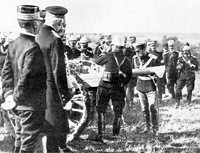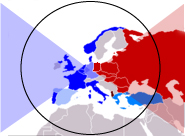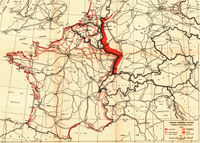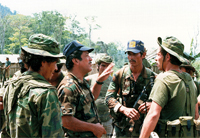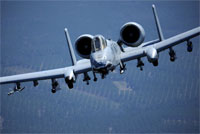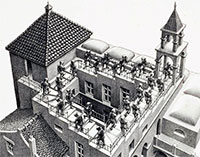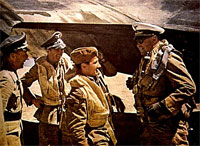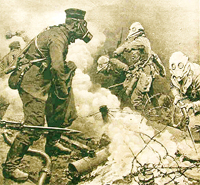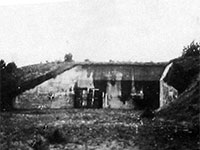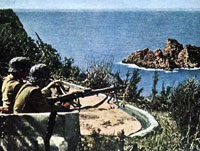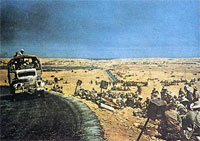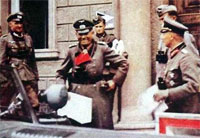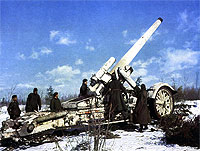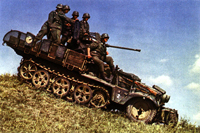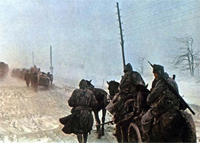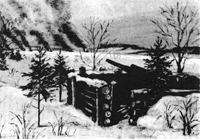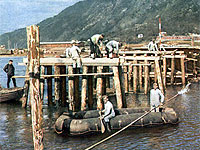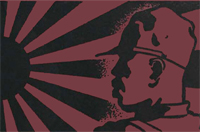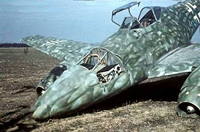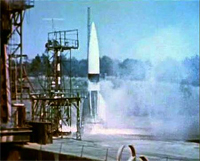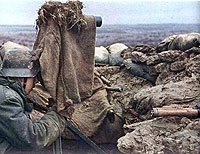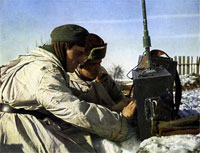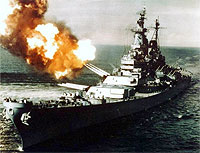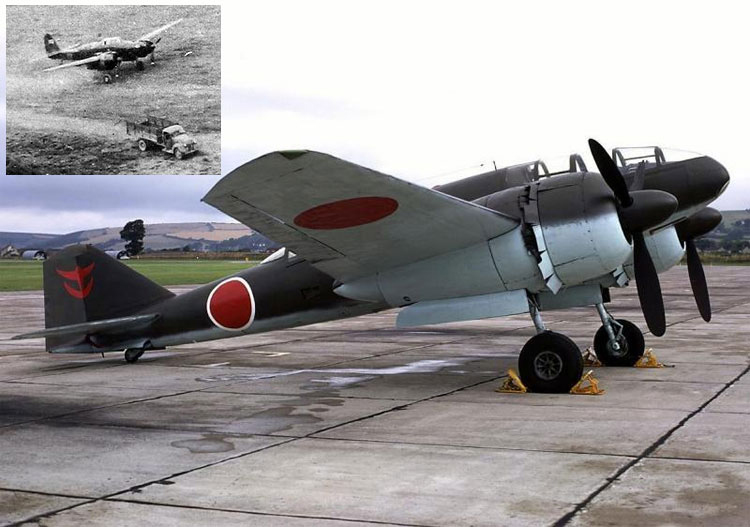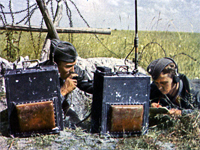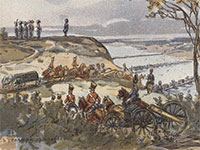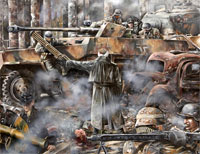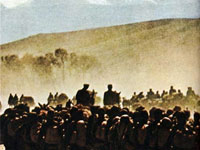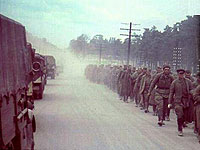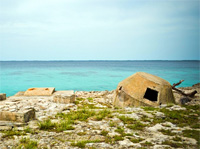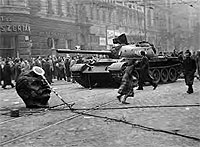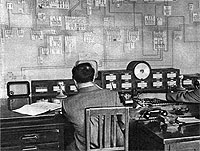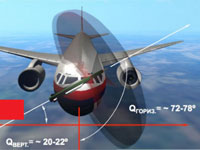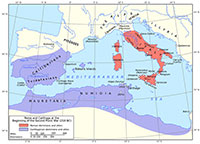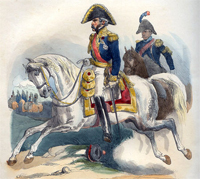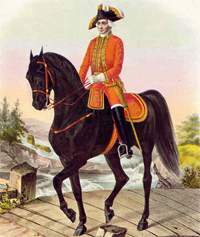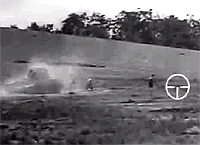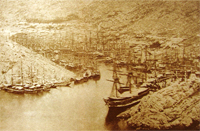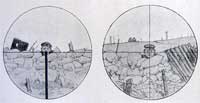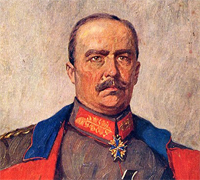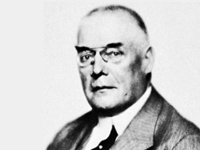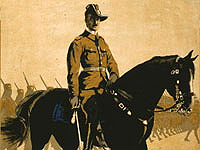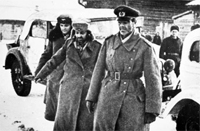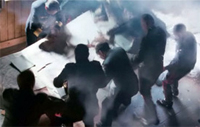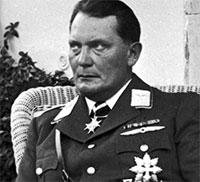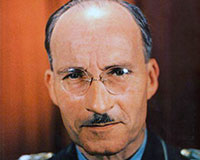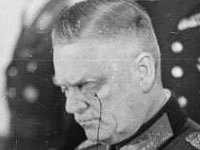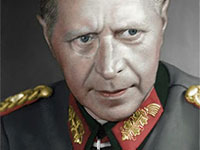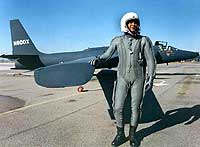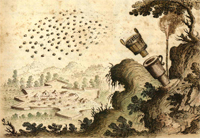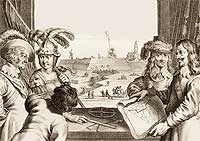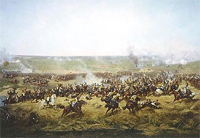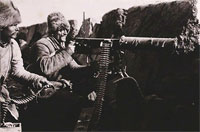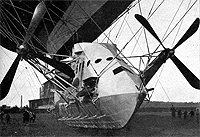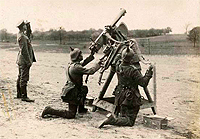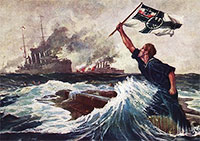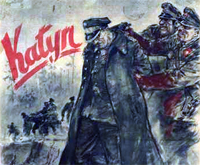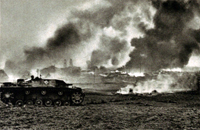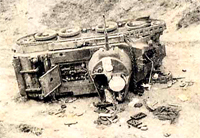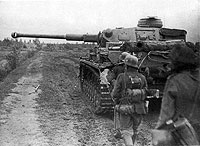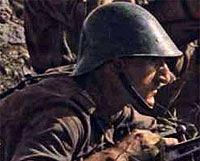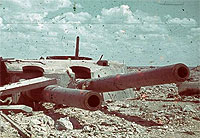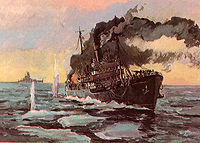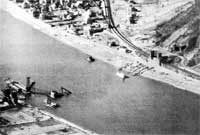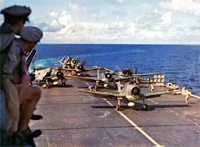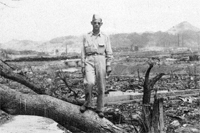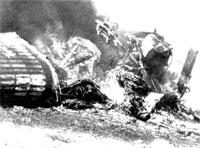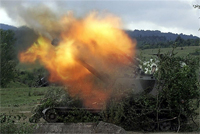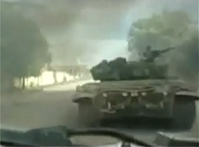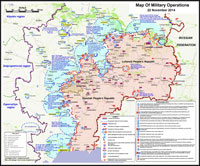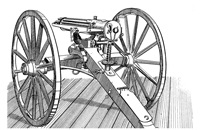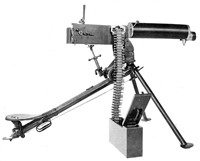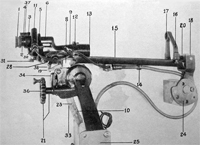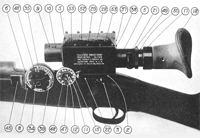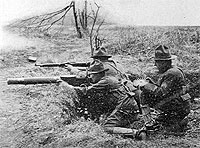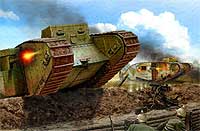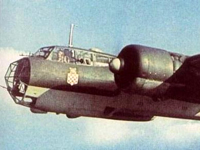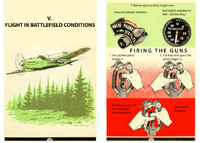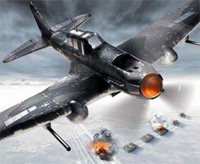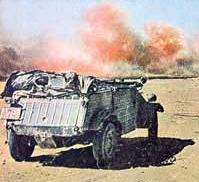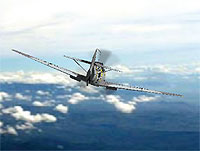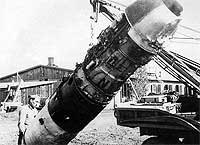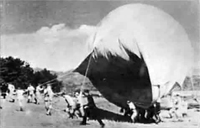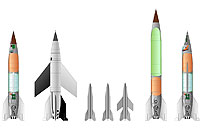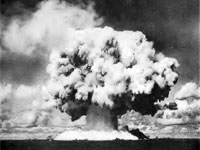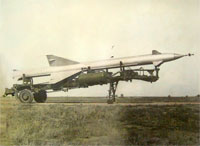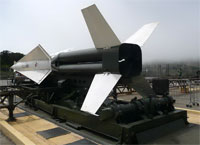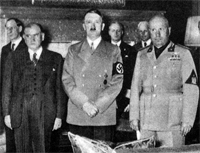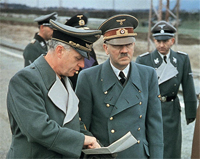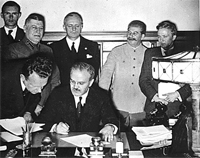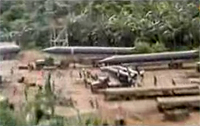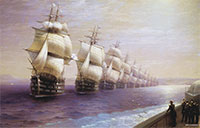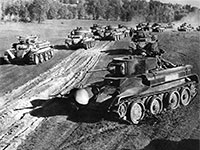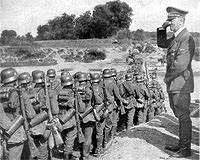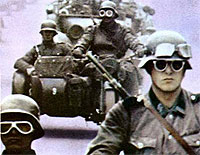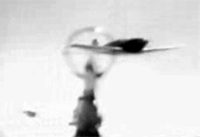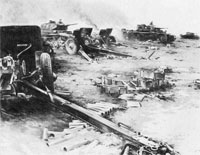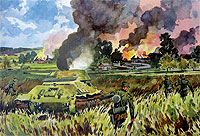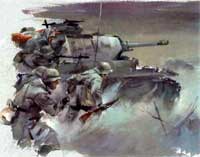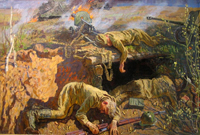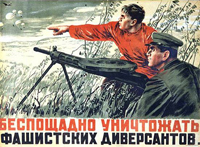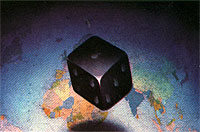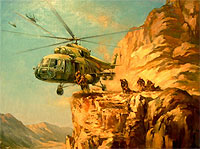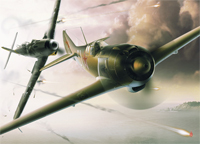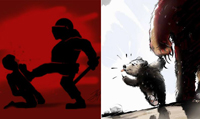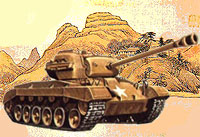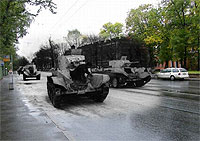Slave to the Game
Online Gaming Community
ALL WORLD WARS
Mediterranean Allied Air Forces. Air Surrender Documents
COMPLETE LIST OF PUBLICATIONS BY SUBJECTS
Doctrines & Theories
Sun Tzu on the Art of War
Romanian and German Troops in Bessarabia, Ukraine and Crimea, 1941-42Romanian and German Troops in Bessarabia, Ukraine and Crimea, 1941-42"Sun Tzu said: The art of war is of vital importance to the State. It is a matter of life and death, a road either to safety or to ruin. Hence it is a subject of inquiry which can on no account be neglected. The art of war, then, is governed by five constant factors, to be taken into account in one's deliberations, when seeking to determine the conditions obtaining in the field. These are: (1) The Moral Law; (2) Heaven; (3) Earth; (4) The Commander; (5) Method and discipline. The MORAL LAW causes the people to be in complete accord with their ruler, so that they will follow him regardless of their lives, undismayed by any danger. HEAVEN signifies night and day, cold and heat, times and seasons. EARTH comprises distances, great and small; danger and security; open ground and narrow passes; the chances of life and death. The COMMANDER stands for the virtues of wisdom, sincerely, benevolence, courage and strictness. By METHOD AND DISCIPLINE are to be understood the marshaling of the army in its proper subdivisions, the graduations of rank among the officers, the maintenance of roads by which supplies may reach the army, and the control of military expenditure. These five heads should be familiar to every general: he who knows them will be victorious; he who knows them not will fail…' >>More
Principles of Strategy by Colonel William K. Naylor
"On the reopening of The General Service Schools in September, 1919, and my return to my former position as Instructor in Strategy and Military History, I found that a desire had developed among American officers for American text-books. To meet this expressed desire and to write a text-book that could be available during the course, I merely had an opportunity to assemble the notes I had used in the past, supplementing them with such reference to The World War as the time would permit. Many of the illustrations used have been taken from our own Civil War." >>More
An Essay on Military Intelligence in War by Jean-Charles Bernis
"The fact that knowledge of the enemy is a factor of success in war is so well proved that no one would dare to deny it seriously. There are still too many, however, who, in spite of the evidence, maintain that this knowledge of the enemy cannot be acquired except by long and difficult research - so long and difficult that the information obtained is almost never of use when it arrives, often incomplete, sometimes false, and that it is just as likely to deceive us as to inform us. They add, moreover, that with the use of rapid means of transportation and the common employment of night movements, the difficulty of getting information in time for it to be used with certainty and precision increases to a pure impossibility. Numerous also are these who are still haunted by the memory of certain notable errors attributed – oftentimes wrongly - to certain G-2 sections, during the war or previous to the war, accused of having misled either the commander or the subordinates." >>More
"Dropshot" - American Plan for War with the Soviet Union in 1957
After Nazi's defeat in 1945, Soviet Union emerged as a new superpower with its own aggressive agenda to promote Communism and eventually, dominate in the world. American Joint Chiefs of Stuff had to contemplate probable Soviet's actions and by 1949 came up with a plan of effective military response. "Dropshot" is a result of these contingency planning, a frightening but realistic scenario of the Third World War, started between NATO and USSR in Europe and all over the world on January 1, 1957. >>More
German Doctrine of the Stabilized Front
"German policy has consistently emphasized the development of highly mobile armies, and Germany's military successes have been gained in wars of maneuver. During the past 25 years the German High Command has become thoroughly convinced of the soundness of the Schlieffen theories of movement, envelopment, and annihilation, especially since Germany's central location- in Europe gives her the advantage of interior lines of communication—a decided strategic advantage in a war of maneuver. Indoctrined and trained in the Schlieffen theories, German armies were successful in the Franco-Prussian War, in World War I (until they became involved in trench warfare of attrition), and in the Polish, Norwegian, and western European campaigns of World War II. However, Germany's central position ceases to be an advantage "whenever her enemies can so combine that they engage her in a two-front war. Her transportation, manpower, and other resources are not sufficient to insure a decisive victory on two sides at once. In order to escape this prospect, the German High Command reached the conclusion that at least one side Germany could and must- secure herself with a great fortified system. A doctrine of permanent fortifications, exhaustive in scope, was formulated under the title "The Stabilized Front" (Die Standige Front). The classic concept of fortifications—isolated fortress cities and a line of fortified works—was abandoned as obsolete. The German High Command developed new principles in the light of modern warfare, weapons, and air power which called for the construction of permanent fortifications in systems of zones, organized in great depth. By "stabilized front" they meant not only the fixed positions which the field armies might be compelled to establish during a campaign, but also the 'deep zones of fortified works which would be constructed in peacetime." >>More
CIA Psychological Operations in Guerrilla Warfare
"Guerrilla warfare is essentially a political war. Therefore, its area of operations exceeds the territorial limits of conventional warfare, to penetrate the political entity itself: the "political animal" that Aristotle defined. In effect, the human being should be considered the priority objective in a political war. And conceived as the military target of guerrilla war, the human being has his most critical point in his mind. Once his mind has been reached, the "political animal" has been defeated, without necessarily receiving bullets. Guerrilla warfare is born and grows in the political environment; in the constant combat to dominate that area of political mentality that is inherent to all human beings and which collectively constitutes the "environment" in which guerrilla warfare moves, and which is where precisely its victory or failure is defined. This conception of guerrilla warfare as political war turns Psychological Operations into the decisive factor of the results. The target, then, is the minds of the population, all the population: our troops, the enemy troops and the civilian population. This book is a manual for the training of guerrillas in psychological operations, and its application to the concrete case of the Christian and democratic crusade being waged in Nicaragua by the Freedom Commandos." >>More
Proceedings of Seminar on Air Antitank Warfare
Romanian and German Troops in Bessarabia, Ukraine and Crimea, 1941-42Romanian and German Troops in Bessarabia, Ukraine and Crimea, 1941-42"On 25 - 26 May 1978 a Seminar on air antitank warfare was held at the Springfield Hilton, Springfield, Virginia. Presentations were made by Mr. John Boyd ("Patterns in Conflict"), Mr. Wayne Coloney ("Armored Warfare: a Frontline Soldier's View"), Mr. Bell (of HERO) ("Nature of the European FEBA"), and Mr. Pierre Sprey ("Countering a Blitz"). These presentations were followed by a question and answer session with former Luftwaffe Colonel Hans-Ulrich Rudel. Colonel Rudel was the most decorated German Officer of World War Two and had the distinction of destroying 519 Soviet tanks with his JU-87G Stuka equipped with two 37-mm cannons." >>More
Psychology of Intelligence Analysis by Richards J. Heuer, Jr.
Romanian and German Troops in Bessarabia, Ukraine and Crimea, 1941-42Romanian and German Troops in Bessarabia, Ukraine and Crimea, 1941-42"This volume pulls together and republishes, with some editing, updating, and additions, articles written during 1978-86 for internal use within the CIA Directorate of Intelligence. Four of the articles also appeared in the Intelligence Community journal Studies in Intelligence during that time frame. The information is relatively timeless and still relevant to the never-ending quest for better analysis." >>More
Military Biography
Hannibal by Theodore Ayrault Dodge
"IN the study of the campaigns of Alexander, original research has been limited to a few travelers and geographers, or to military men conducting explorations under the auspices of some government and provided with facilities denied to most of us. In the case of Hannibal it is different. Spain and Italy are accessible, as Persia and Afghanistan are not, and the topography of the theatre of the Second Punic War can be readily examined and ascertained. No historian of Hannibal appears, however, to have studied his campaigns on the ground. Almost all accounts of his extraordinary marches, manoeuvres and battles borrow their topography, if they give any, from some predecessor equally limited in his facilities, or from very insufficient maps. Many errors have thus been propagated. The author has been fortunate enough repeatedly to visit the scenes of the Punic captain's achievements. With Polybius and Livy in the hand, he has followed Hannibal from Cartagena across the Pyrenees, the Rhone and the Alps, crossing every pass in the latter range by which the Carthaginian army could possibly have made its way; he has visited every section of Italy and has compared the facts given by the ancient writers with the existing topography; he has been able to consult the best authorities as to the geological changes which the centuries may have wrought: and what he has herein described is from diligent study of the authorities on the ground. This course has enabled him to correct some errors which naturally enough have crept into history, and to harmonize some of the statements of the old authors which have been deemed irreconcilable." >>More
The Life of Admiral Togo by Arthur Lloydtthias Dogenby Matthias Dogenby Matthias Dogen
Romanian and German Troops in Bessarabia, Ukraine and Crimea, 1941-42Romanian and German Troops in Bessarabia, Ukraine and Crimea, 1941-42 "For the imperfections of the present volume I can only plead that I hope it may prove to be a first edition, and that further studies and the publication of more detailed information may enable me at some future time to complete, or at least to elaborate, the biography of a great man in whom the whole world is interested.The modest and retiring life which Admiral Togo has hitherto lived has made it difficult for the biographer to collect many picturesque incidents relating to his early years. But modesty is one of the greatest of virtues, and that he has always exhibited this virtue in so conspicuous a manner seems to be one of the elements which make the greatness of his character." >>More
Kesselring: an Analysis of the German Commander at Anzio by Teddy D. Bitner
Romanian and German Troops in Bessarabia, Ukraine and Crimea, 1941-42Romanian and German Troops in Bessarabia, Ukraine and Crimea, 1941-42"This study attempts to analyze the decisions made by Field Marshal Albert Kesselring prior to and during the battle of Anzio in February 1944. The focus of the investigation is on Kesselring’s decision to shift Army Group reserves from the Rome area prior to the Allied amphibious assault at Anzio on 18 January 1944, then his involvement in the development and execution of the German counterattack against the Allied beachhead conducted on 16 February 1944. The investigation reveals that Kesselring, the Army Group Commander, made a proper and effective decision in committing the Army Group reserves to the German defensive line prior to the invasion, and that his involvement in the development and execution of the German counterattack at Anzio was doctrinally sound and generally effective." >>More
Military Research
A Survey of German Tactics 1918
"A survey of German tactics during 1918 is facilitated by the dramatic change that came over the situation on the 18th of July. Up to that date we are concerned with offensive tactics; after that date only with defensive. The subject thus naturally divides in two. At the head of the German Army as the spring campaign opened was Field Marshal von Hindenburg, an exponent of offensive tactics, who had up till then, and quite recently in the attack on Riga, met with remarkable successes. In the early phases of the war, and on the Eastern front, Hindenburg had more or less practiced von Schlieffen's Cannae theory,—the refusal of the centre and double envelopment of the wings. With the immense frontal developments of the later stages of the war, this tactical scheme became less and less workable and the tendency became rather to search out and exploit a weak point in the opponent's line." >>More
Album of the Mannerheim Line Fortifications 1938
"This album was compiled by the Soviet military intelligence in 1938 and issued to the Soviet Army High Command. Kirill Meretzkov (Leningrad Military District Commander in 1939-40). “For example, we have the Album of enemy’s fortified positions and it was the most valuable source we used for the operational planning. I always kept it on my table, on the left side.” (Original was found in the Leningrad Military District archive)." >>More
The German Campaign in the Balkans, 1941, by Mueller-Hillebrand
"The tentative study, "The German Campaigns in the Balkans (Spring 1941)," is an account of a Nazi blitz in which political machinations and military policy were synchronised and utilized to insure rapidity in decision, in planning, in concentration, end in operations. The campaigns culminated in the largest mass airborne attack that had ever been launched up to that time. The success of this action captivated the minds of Allied military men and probably helped create the very considerable airborne force organized by Great Britain and the United States. Little did they know at the time of the serious loss sustained by the Germans who never again employed any considerable number of airborne troops in an air landing. It is believed that this study, although tentative, will prove of interest and of value to all serious military students." >>More
Airborne Invasion of Crete, May 1941
"The drama of Crete marks an epic in warfare. The concept of the operation was highly imaginative, daringly new. Combat elements drawn from Central Eerope moved with precision into funnel shaped Greece. Here they re-formed, took shape as a balanced force, were given wings. The operation had the movement, rhythm, harmony of a master1s organ composition. On 20 May and succeeding days this force soared through space; its elements broke over CRETE in thundering crescendos - all stops out. For the first time in history airborne troops, supplied and supported, by air, landed in the face of an enemy, defeated him. For the first time an air force defeated a first-rate Navy, inflicted such staggering losses that the fleet was ordered back to Alexandria three days after the battle started." >>More
German Exploitation of Arab Nationalist Movements in World War II
"German exploitation of the Arab nationalist movements in World War II extended from the field of strategic planning at the highest levels of command to the military measures actually taken. General der Flieger Helmut Felmy has presented an account of the military measures taken by Germany. Under the terms of Hitler's Directive No. 30 of 23 May 1941, and the "Service Regulations for Special Staff F" of 21 June 1941, General Felmy was appointed as the central authority for all Arab affairs concerning the Wehrmacht. Of all contemporary authorities on the subject still available, he therefore has the most thorough knowledge of the military steps actually taken on the German side." >>More
Flank Defense in Far Reaching Operations by Heinz Guderian, 1948
"This study will chiefly be concerned with the operations of the Second Panzer Army which were commanded by the author. The theme will also be illustrated with examples from other Panzer Armies." >>More
Tactics and Fire Control of Russian Artillery in 1941-44 by Oberst H.-G. Richert
"The author of the study ... was regarded as an expert in the field of artillery. In his subsequent service as a divisional general stuff officer in the East he was able to further broaden his artillery experience and to add to it by learning from the judgement of his divisional commander, who had been active in the ield service of the artillery in the East. Finally, when he assumed command of an infantry regiment... he observed with the trained eye of an artilleryman, the heavy battles in which he led his infantry regiment with great skill. As a result, he seemed particularly suited to write this study. The author has written his observations on Russian artillery tactics in five chapters. In these, a total of six engagements are described and the lessons to be learned from them have been indicated." >>More
German Minefields at Alamein (October - November, 1942)
"The accompanying report from British sources on enemy minefields at Alamein is published for the information of all concerned. This is the most complete and succinct report published to date." >>More
Terrain Factors in the Russian Campaign
"This pamphlet was compiled from a series of reports written especially for the Historical Division, EUCOM, by several former German generals. All of these officers had extensive combat experience during World War II, especially on the eastern front. The principal author, for example, was successively chief of staff of a corps in France and Holland (1939-40), commander of an infantry division in northern and central Russia (1941-43), instructor at a school for division commanders in Berlin (1943), commander of a corps in southern Russia (1943-44), and acting commander of an army in southern Russia (1944)." >>More
Effects of Climate on Combat in European Russia
"This study was prepared by a committee of former German generals and general staff officers under the supervision of the Historical Division, EUCOM. The material, based on the personal experiences of the principal author and his associates, was written largely from memory, with some assistance from diaries, earlier studies, and documents. All the German officers involved had extensive experience on the Eastern Front during the period 1941-45. The principal author, for example [Raus], commanded in succession a panzer division, a panzer army, and an army group. " >>More
Small Unit Actions During the German Campaign in Russia
The purpose of this text is to provide small unit commanders with instructional material, at their own level, concerning the Russian front during World War II. A careful study of the examples in the text will provide many lessons in tactics, logistics, and techniques, in the coordination of weapons, in the influence of terrain, climatic and weather conditions upon operations, and in the qualities of the officers and men who fought on the Russian front. It is only by utilizing German experience that the best insight into the fighting on that front can be secured. >>More
Comments on Russian Roads and Higways by Max Bork
Romanian and German Troops in Bessarabia, Ukraine and Crimea, 1941-42Romanian and German Troops in Bessarabia, Ukraine and Crimea, 1941-42"Comments on Russian Railroads and Highways," was originally prepared in German under the supervision of Historical Division, USAREUR. The author, Gen. Lt. a.D. Max Bork, in 1939 and I940 was a Branch Chief in the Transportation Division of the German Army General Staff." >>More
Battlefield Air Interdiction by the Luftwaffe at the battle of Kursk 1943 by William Dalecky
Romanian and German Troops in Bessarabia, Ukraine and Crimea, 1941-42Romanian and German Troops in Bessarabia, Ukraine and Crimea, 1941-42"This study attempts to show the misapplication of tactical airpower by the Luftwaffe in support of German ground forces during the Battle of Kursk in July 19^3- The analysis is based on the investigation of historical references and provides lessons learned which, might, be applied in future conflicts. The study shows that the Luftwaffe concentrated its efforts at Kursk on Close Air Support and neglected Battlefield Air Interdiction. This was primarily because Close Air Support had' proven itself so successful in German experience prior to Kursk. However, the failure of the Luftwaffe to interdict Russian reinforcements at Kursk proved to be critical and contributed to the German defeat. Air planners must realize that a correct balance between Close Air Support and Battlefield Air Interdiction is essential to the efficient use of airpower during any tactical application in support of ground forces. Neither Close Air Support nor Battlefield Air Interdiction should gain primacy in doctrine, rather, a mix of the two should be applied on a situational basis." >>More
Japanese in Battle. First & Second Editions. 1943, 1944
"This pamphlet is largely the work of soldiers and airmen fighting in Burma and the South West Pacific who, in notes, sketches and photographs, have recorded their observations of the Japanese in Battle." [Foreword to the First edition]. "The object of this pamphlet is to indicate briefly the chief characteristics of Japanese behaviour in the field as they differ from our own and that of western generally. Principles and methods which the Japanese share with most other armies are touched on lightly or passed over. Japanese strategy, though it too is strong peculiarities, is not dealt with in this pamphlet, which restricts itself to tactics, major and minor. The description of Japanese tactics is based on observation of Japanese practice in the field rather than on the rules laid down in Japanese ulitary handbooks, to which their practice often bears little relation.[Introduction to the second edition]. >>More
Principles and Experiences of Position Warfare by Walter Hartmann
Analysis of German experience in positional warfare and retrograde movement, written from memory by the former commanding officer of the 87th Infantry Division Walter Hartmann in 1947, includes two parts: "description of the principles and experiences about the position warfare of a division"; and "description of the principles and experiences about of a withdrawal movement of the division, carried out in phases over a depth of 60 km." >>More
Cryptanalysis in the German Air Force by Waldemar Werther
Romanian and German Troops in Bessarabia, Ukraine and Crimea, 1941-42Romanian and German Troops in Bessarabia, Ukraine and Crimea, 1941-42"During the period of preparation for the establishment of the intercept equipment of the Air Force in 1936, the first State employees intended for cryptanalysis (who were all of them civilians up to the outbreak of the war) were sent to the permanent intercept posts of the Army in the East for the purpose of basic training. The results of this training were unsatisfactory because the Army was reticent in releasing even the most elementary information, and furthermore, because the individuals sent lacked in most cases the necessary qualifications for their work; the personnel officials made their selections on anything but a proper basis, and appointed many persons who turned out to be completely unsuitable for the work of a cryptanalyst. The creation of a capable and successful cryptanalytic group was accomplished only in the course of the following years of tiresome work, without outside assistance, and through an internal development achieved by dropping numerous unsatisfactory elements." >>More
The Defeat of the German Air Force
On 6 June 1944, General Eisenhower was able to say, "If you see fighter aircraft over you, they will be ours." This remark signalized the achievement of the first objective of the Allied Air Forces In Europe: the reduction of the GAF as an effective deterrent to land or air invasion. This attainment of superiority over the GAF, given priority in the Casablanca Directive of January 1943, was the result of concentrated air action during the nine months prior to D-Day by the Allied Air Forces In the European Theater. It was brought about primarily through: a) Attrition of the enemy fighter force in the air and on the ground, and the consequent deterioration of the quality of enemy fighter pilots; b) Attacks on enemy aircraft production which caused vital delay in the expansion of the GAF fighter force. The air superiority gained before D-Day was maintained throughout 1944 and 1945 by the combined efforts of the RAF and USAAF through attrition and c) Destruction of the sources of enemy aircraft fuel production; d) Disruption of the GAF system for supply and repair caused by attacks on the German transportation. >>More
V-Weapons (Crossbow) Campaign
The code word "Crossbow" was used throughout the period of planning and operations as a convenient term for any matters relating to the attack on England by long range weapons, including all counter-measures against such attacks. It is used in the same sense in this paper, although after D-day the term included attacks against continental targets as well. This report does not attempt to be a complete account of the development and exploitation of "secret weapons" by Germany, nor a detailed and final appraisal of the success or failure of the counter-measures employed against them. This report attempts rather to consider the "Crossbow" campaign as an influence on the operational pattern of the Strategic Air Forces. Considerable background material has been included to place in better perspective a subject which has been clouded by secrecy and distorted by propaganda. >>More
German Field Fortifications on the Eastern Front
This album contains original drawings of German field fortifications on the Eastern Front, made in 1943-1944. Prepared for publication by Engineering Department of Soviet Army in 1945-1946, album remained in archives as a manuscript, until its recent discovery and publication on www.fortifications.ru, which kindly gave us permission for reproduction. (Special thanks to Oleg V. Tulnov.). "The album was developed with a purpose to familiarize staff of the Land forces with types and designs of field fortifications, which were used by German defense. This album is based on the Reports of Fronts Engineering Departments and various commissions, created under Chief of Military Engineering. The album contains 7 sections: I. Opened Fire Positions. II. Covered Fire Positions. III. Observation Posts. IV. Shelters. V. Preparing Local Environment for Defense. VI. Anti-tank and Anti-personnel Obstacles. VII. Camouflage." >>More
German Radio Intelligence by Lieutenant-General Albert Praun
"Because of the difficulties encountered in this highly specialized field the topic required treatment by an expert of recognized standing. Since such an expert was not available among the men in the German Control Group working under the supervision of the Historical Division, SUCOM, the writing of the over-all report was assigned to General Praun. By virtue of the knowledge acquired by him in his military career, and especially during the tenure of his final position, General Praun has a thorough grasp of German radio intelligence. Moreover, as a result of his acquaintance with German signal service personnel, he was able to obtain the co-operation of the foremost experts in this field." >>More
Iwo Jima Naval Gunfire Support
"In planing Naval Gunfire support for the attack on Ivo Jima, emphasis was laid on combining and applying the techniques developed in earlier bombardment of small atolls with those developed during the bombardment of the MARIANAS, where terrain features dictated many special measures in control of fire. Particular attentign was given to improving air spot facilities and to arranging that an experienced gunnery staff be present during preliminary bombardments that an experienced gunnery staff be present during preliminary bombardments aboard an AGC to interpret and apply current target intelligence to the targets upon which fire was to be delivered.">>More
Photo Interpreter's Guide to Japanese Military Installations, 1945
"Specialized knowledge and guides are usually necessary to make identifications of enemy weapons, field equipment, and installations on air reconnaissance photographs. This publication, arranged as a guide for ground force interpreters, is intended primarily for men with the specialized knowledge requisite to derive maximum information from aerial photographs. Photographic examples are given of typical Japanese installations and materiel." >>More
German Traffic Analysis of the Russian Communications
"The contents of this volume deal with German exploitation of Russian communications through Traffic Analysis. There is not as much source material available on Russia as there is on United States and England. The main interest of the interrogation officers normally was centered on gaining intelligence concerning American and British communications, and consequently, interest concerning German activity on the communications of other countries had to be of secondary importance. In addition, because of the conditions under which many of the interrogations were conducted—a number of them being made in active combat zones—there were often times great difficulties encountered in carrying out even the necessary routine line of questioning. Even had there been ideal conditions under which to work it is probable that not much more intelligence could have been obtained on Russian communications because the German personnel who were engaged in that work were in the Russian zone of operations. Only a few of these fell into English or American hands—the Russians capturing the others. However, the material which is, available does give a fairly adequate, though not complete, picture of Russian communications as seen by the German Traffic Analyst." >>More
The Effects of Infectious Disease on Napoleon's Russian Campaign by B. Allen
"This paper will discuss the effects of infectious disease on Napoleon’s forces during the Russian campaign of 1812. In short, it will argue that the primary reason Napoleon failed to defeat the Russian army was because his forces were decimated by disease, specifically typhus, dysentery, and diphtheria. It will also demonstrate the effect of disease and illness on Napoleon’s judgement and decision-making process." >>More
The German Defense of Berlin 1945, by Oberst Wilhelm Willemer
"No cohesive, over-all plan for the defense of Berlin was ever actually prepared. All that existed was the stubborn determination of Hitler to defend the capital of the Reich. Circumstances were such that he gave no thought to defending the city until it was much too late for any kind of advance planning. Thus the city's defense was characterized only by a mass of improvisations. These reveal a state of total confusion in which the pressure of the enemy, the organizational chaos on the German side, and the catastrophic shortage of human and material resources for the defense combined with disastrous effect. The author describes these conditions in a clear, accurate report which I rate very highly. He goes beyond the more narrow concept of planning and offers the first German account of the defense of Berlin to be based upon thorough research. I attach great importance to this study from the standpoint of military history and concur with the military opinions expressed by the author." >>More
Ultra and The Myth of the National Redoubt by Marvin L. Meek
Romanian and German Troops in Bessarabia, Ukraine and Crimea, 1941-42Romanian and German Troops in Bessarabia, Ukraine and Crimea, 1941-42"This study investigates the creation of a mythical fortifications system called the German "National Redoubt" and the use of ULTRA to confirm its existence. The work includes a brief background of the Redoubt and examines how the state of intelligence at Supreme Headquarters Allied Expeditionary Force helped turn enemy propaganda into "reality." The study addresses the influence of ULTRA intelligence at Supreme Headquarters during the final phase of the war in Europe. This study, investigates whether SHAEF used ULTRA to confirm or deny intelligence gathered through conventional means." >>More
Peculiarities of Russian Warfare by Erhard Raus
Romanian and German Troops in Bessarabia, Ukraine and Crimea, 1941-42Romanian and German Troops in Bessarabia, Ukraine and Crimea, 1941-42"PECULIARITES OF RUSSIAN WARFARE”was prepared by a committee of former German generals and general staff corps officers at the EUCOM Historical Division Interrogation Enclosure, Neustadt, Germany, in late 1947 and early 1948. The names of the committee members are not being announced at this time. All members, however, had extensive experience on the Eastern Front during the period 1941-45. The principal author[Raus], for example, commanded, in succession, a panzer division, a corps, a panzer army, and an army group." >>More
The Taylor Committee Investigation of the Bay of Pigs by Jack B. Pfeiffer
Romanian and German Troops in Bessarabia, Ukraine and Crimea, 1941-42Romanian and German Troops in Bessarabia, Ukraine and Crimea, 1941-42"More than twenty years after the event, CIA personnel who were closely involved in the Bay of Pigs (BOP) operation continue to speak bitterly about the outcome. That the criticism of the Agency for its "fiasco" began even as the search for survivors from the beaches at Playa Giron and Playa Larga was underway—and continues to the present—has done nothing to mollify the feelings of those who were involved that they have taken a "bum rap" for a political decision which insured the military defeat of the anti-Castro forces the Agency had been authorized to organize and train for the overthrow of Fidel Castro." >>More
Revolutionary Forces Hungarian Revolution 1956 by Zoltan Virag
Romanian and German Troops in Bessarabia, Ukraine and Crimea, 1941-42Romanian and German Troops in Bessarabia, Ukraine and Crimea, 1941-42"The aim of this thesis is to provide insight and analysis of the factors that contributed to the military success of the revolutionary forces against the Hungarian and Soviet armed and security forces during the early phase of the 1956 Hungarian Revolution 1956. The thesis in the beginning substantiates an overall comprehension of the Hungarian political, economical, and social conditions from 1953 till 1956. The presentation of this time period facilitates the understanding of the circumstances leading to the revolution break out. Furthermore, thesis examines the legal and legitimacy questions of the Soviet military intervention in the framework of the Treaty of Friendship, Cooperation and Mutual Assistance, commonly known as the Warsaw Pact." >>More
The Decryption of the Picture by Henry Lowenhaupt
Romanian and German Troops in Bessarabia, Ukraine and Crimea, 1941-42Romanian and German Troops in Bessarabia, Ukraine and Crimea, 1941-42"One day in August 1958 Charles V. Reeves showed me a picture of the Sverdlovsk Central Dispatching Office of the Urals Electric Power System which he had found in the July issue of Ogonek, the Soviet equivalent of Look magazine (Figure 1a). He remarked that at the Boston Edison Company he had controlled electric power generation and flow in the Boston metropolitan area from just such a dispatching station." >>More
Mutiny on Storozhevoy
Romanian and German Troops in Bessarabia, Ukraine and Crimea, 1941-42Romanian and German Troops in Bessarabia, Ukraine and Crimea, 1941-42"In November 1975, a group of sailors led by the ship's political officer took over the Soviet "Krivak" class destroyer "Storozhevoy" and attempted to sail to Sweden to seek asylum. They were attacked and turned back by Soviet naval and air units. Information of this dramatic event which has never been acknowledged by the Soviets, made it to the West only piece by piece. It was the intent of this study to assemble all available data for critical analysis to determine potential causes and implications." >>More
Flight MH17 Destruction on July 17, 2014 near Donetsk, Ukraine, Presentation by Almaz-Antey
Romanian and German Troops in Bessarabia, Ukraine and Crimea, 1941-42Romanian and German Troops in Bessarabia, Ukraine and Crimea, 1941-42Co-pilot of the Malaysian Boeing 777, shot down over Ukraine on July 17, 2014 could notice the approaching anti-aircraft missile launched from "Buk-M1" self-propelled launcher at the last moment before it exploded near the nose of the aircraft, and the right side of the cockpit was literally cut off from the fuselage. Such conclusions can be drawn from the full version of the presentation by "Almaz-Antey", leading Russian defense contractor, which took part in SAM BUK (SA-11) development during the late 1970s and 1980s.Full version of the presentation, shown at the "Almaz-Antey" briefing on June 2, 2015 consists of 53 slides (some showed only names of the presentation sections and were skipped in this translation- AWW) and was divided into three parts. This document contains damage analysis of the airplane and simulation of the 9M38M1 missile approach to its target, as well as photographs, charts, initial data, graphic models and other information. >>More
Net Reconstruction - A Basic Step in Traffic Analysis by Seaburne Report
Net Reconstruction - A Basic Step in Traffic Analysis by Seabourne ReportThis is an explanation, for those unfamiliar with the subject, of the nature of net reconstruction of the communications and the techniques usually used to accomplish it.Communications intelligence is possible because any organization, particularly a military organization in battle, must carry on rapid communications to achieve planned, coordinated, and effective action. Often, radio is used, but because radio is susceptible to interception, disguises become necessary to conceal the content of the message traffic and the organization's structure. >>More
Armies & Forces
French Army from Revolution to the First Empire
Illustrations by Hippolyte Bellangé from the book P.-M. Laurent de L`Ardeche «Histoire de Napoleon», 1843 >>More
Russian Horse Guards Commemorative Manual 1730-1930
"The present volume is a Hand Book of the Horse Guards published by His Imperial Highness Grand Duke Dmitri of Russia, President: of Honour of the Association of Former Officers of the Horse Guards, Imperial Russian Guards, on the occasion of the commemoration of the 200th anniversary of the foundation of this regiment, which took place in Paris on April 26th, 1931." >>More
USSR NAVY, by Division of Naval Intelligence, 1943
"This serial contains all pertinent information concerning the Navy of the U.S.S.R available in the Division of Naval Intelligence. It covers the organization of the Soviet Navy, naval policy, personnel, tactics and operations, naval ordnance, an estimate of the strength and disposition of the various fleets and descriptions of the units which comprise them, descriptions of all known naval bases and yards, of the naval air force and of coast defense." >>More
German Snipers Field Training, 1944
This video includes 2 training films: Snipers Field Training: Masters of Camouflage and Deception, Training film for the German Air Force High Command (38 min) and Snipers in action: the Unseen Weapon, Training film of the German Army High Command No 668, Spring 1944 (30 min). German narrator, with English subtitles. >>More
Military Memoires
Balaclava and the Sevastopol Inquiry
Dramatic report of W.Gordon, commanding officer of H.M.S. Sansapareil regarding condition of Balaclava harbour during the winter of 1854/55 in Crimea. >>More
The First Ironclad Engagement in the World by E.V.White
"WERE the present a period of war between the States, the reader could readily appreciate the occasion for this publication. In that event, the novelty of the new instrument of destruction—the Iron-Clad—would intensely interest the military student, and the skill and courage manifested by the combatants would stir the enthusiasm and call forth the patriotism of the reader." >>More
From Libau to Tsushima by Eugene Politovsky
EUGENE POLITOVSKY, Chief engineer of the 2nd Fleet, was born at Tashkent on November 12th, 1874. He received his education at the Emperor Nicholas I. Naval Engineering School, and graduated it in 1897. Up to the departure of the fleet for the East he served at the Admiralty at St. Petersburg. He went down in his ship, the battleship Prince Suvaroff, in the fight of May 14th, 1905. This diary consists of extracts from his letters to his wife, which it must be understood were not intended for publication. The diary is written entirely from the personal point of view of the author. He shares with the human being dearest to him everything that occupies or interests him. He writes in fragments, with detached sentences, sometimes snatching a few spare minutes from his duties for his letters. His diary is a full one. Scarce a day is omitted from the departure from Libau up to May 14th. Involuntarily, one is impressed by the sincerity and justice of the author's tone. As he thought, so he wrote.His style is very simple and graphic, despite its fragmentary nature. The author was a fleet engineer, not a sailor. This was his first cruise. His views of all that he saw are those of an independent person, bound by no traditions or clannishness. They appear to be absolutely impartial. In addition, through his position on the staff he knew much that remained unknown to others. >>MoreEUGENE POLITOVSKY, Chief engineer of the 2nd Fleet, was born at Tashkent on November 12th, 1874. He received his education at the Emperor Nicholas I. Naval Engineering School, and graduated it in 1897. Up to the departure of the fleet for the East he served at the Admiralty at St. Petersburg. He went down in his ship, the battleship Prince Suvaroff, in the fight of May 14th, 1905. This diary consists of extracts from his letters to his wife, which it must be understood were not intended for publication. The diary is written entirely from the personal point of view of the author. He shares with the human being dearest to him everything that occupies or interests him. He writes in fragments, with detached sentences, sometimes snatching a few spare minutes from his duties for his letters. His diary is a full one. Scarce a day is omitted from the departure from Libau up to May 14th. Involuntarily, one is impressed by the sincerity and justice of the author's tone. As he thought, so he wrote.His style is very simple and graphic, despite its fragmentary nature. The author was a fleet engineer, not a sailor. This was his first cruise. His views of all that he saw are those of an independent person, bound by no traditions or clannishness. They appear to be absolutely impartial. In addition, through his position on the staff he knew much that remained unknown to others. >>MoreEUGENE POLITOVSKY, Chief engineer of the 2nd Fleet, was born at Tashkent on November 12th, 1874. He received his education at the Emperor Nicholas I. Naval Engineering School, and graduated it in 1897. Up to the departure of the fleet for the East he served at the Admiralty at St. Petersburg. He went down in his ship, the battleship Prince Suvaroff, in the fight of May 14th, 1905. This diary consists of extracts from his letters to his wife, which it must be understood were not intended for publication. The diary is written entirely from the personal point of view of the author. He shares with the human being dearest to him everything that occupies or interests him. He writes in fragments, with detached sentences, sometimes snatching a few spare minutes from his duties for his letters. His diary is a full one. Scarce a day is omitted from the departure from Libau up to May 14th. Involuntarily, one is impressed by the sincerity and justice of the author's tone. As he thought, so he wrote.His style is very simple and graphic, despite its fragmentary nature. The author was a fleet engineer, not a sailor. This was his first cruise. His views of all that he saw are those of an independent person, bound by no traditions or clannishness. They appear to be absolutely impartial. In addition, through his position on the staff he knew much that remained unknown to others. >>MoreEUGENE POLITOVSKY, Chief engineer of the 2nd Fleet, was born at Tashkent on November 12th, 1874. He received his education at the Emperor Nicholas I. Naval Engineering School, and graduated it in 1897. Up to the departure of the fleet for the East he served at the Admiralty at St. Petersburg. He went down in his ship, the battleship Prince Suvaroff, in the fight of May 14th, 1905. This diary consists of extracts from his letters to his wife, which it must be understood were not intended for publication. The diary is written entirely from the personal point of view of the author. He shares with the human being dearest to him everything that occupies or interests him. He writes in fragments, with detached sentences, sometimes snatching a few spare minutes from his duties for his letters. His diary is a full one. Scarce a day is omitted from the departure from Libau up to May 14th. Involuntarily, one is impressed by the sincerity and justice of the author's tone. As he thought, so he wrote.His style is very simple and graphic, despite its fragmentary nature. The author was a fleet engineer, not a sailor. This was his first cruise. His views of all that he saw are those of an independent person, bound by no traditions or clannishness. They appear to be absolutely impartial. In addition, through his position on the staff he knew much that remained unknown to others. >>MoreEUGENE POLITOVSKY, Chief engineer of the 2nd Fleet, was born at Tashkent on November 12th, 1874. He received his education at the Emperor Nicholas I. Naval Engineering School, and graduated it in 1897. Up to the departure of the fleet for the East he served at the Admiralty at St. Petersburg. He went down in his ship, the battleship Prince Suvaroff, in the fight of May 14th, 1905. This diary consists of extracts from his letters to his wife, which it must be understood were not intended for publication. The diary is written entirely from the personal point of view of the author. He shares with the human being dearest to him everything that occupies or interests him. He writes in fragments, with detached sentences, sometimes snatching a few spare minutes from his duties for his letters. His diary is a full one. Scarce a day is omitted from the departure from Libau up to May 14th. Involuntarily, one is impressed by the sincerity and justice of the author's tone. As he thought, so he wrote.His style is very simple and graphic, despite its fragmentary nature. The author was a fleet engineer, not a sailor. This was his first cruise. His views of all that he saw are those of an independent person, bound by no traditions or clannishness. They appear to be absolutely impartial. In addition, through his position on the staff he knew much that remained unknown to others. >>MoreUGENE POLITOVSKY, Chief engineer of the 2nd Fleet, was born at Tashkent on November 12th, 1874. He received his education at the Emperor Nicholas I. Naval Engineering School, and graduated it in 1897. Up to the departure of the fleet for the East he served at the Admiralty at St. Petersburg. He went down in his ship, the battleship Prince Suvaroff, in the fight of May 14th, 1905. This diary consists of extracts from his letters to his wife, which it must be understood were not intended for publication. The diary is written entirely from the personal point of view of the author. He shares with the human being dearest to him everything that occupies or interests him. He writes in fragments, with detached sentences, sometimes snatching a few spare minutes from his duties for his letters. His diary is a full one. Scarce a day is omitted from the departure from Libau up to May 14th. Involuntarily, one is impressed by the sincerity and justice of the author's tone. As he thought, so he wrote.His style is very simple and graphic, despite its fragmentary nature. The author was a fleet engineer, not a sailor. This was his first cruise. His views of all that he saw are those of an independent person, bound by no traditions or clannishness. They appear to be absolutely impartial. In addition, through his position on the staff he knew much that remained unknown to others. >>MoreEUGENE POLITOVSKY, Chief engineer of the 2nd Pacific Fleet, was born at Tashkent on November 12th, 1874. He received his education at the Emperor Nicholas I. Naval Engineering School, and graduated it in 1897. Up to the departure of the fleet for the East he served at the Admiralty at St. Petersburg. He went down in his ship, the battleship Prince Suvaroff, in the fight of May 14th, 1905. This diary consists of extracts from his letters to his wife, which it must be understood were not intended for publication. The diary is written entirely from the personal point of view of the author. He shares with the human being dearest to him everything that occupies or interests him. He writes in fragments, with detached sentences, sometimes snatching a few spare minutes from his duties for his letters. His diary is a full one. Scarce a day is omitted from the departure from Libau up to May 14th. Involuntarily, one is impressed by the sincerity and justice of the author's tone. As he thought, so he wrote.His style is very simple and graphic, despite its fragmentary nature. The author was a fleet engineer, not a sailor. This was his first cruise. His views of all that he saw are those of an independent person, bound by no traditions or clannishness. They appear to be absolutely impartial. In addition, through his position on the staff he knew much that remained unknown to others. >>MoreENE POLITOVSKY, Chief engineer of the 2nd Fleet, was born at Tashkent on November 12th, 1874. He received his education at the Emperor Nicholas I. Naval Engineering School, and graduated it in 1897. Up to the departure of the fleet for the East he served at the Admiralty at St. Petersburg. He went down in his ship, the battleship Prince Suvaroff, in the fight of May 14th, 1905. This diary consists of extracts from his letters to his wife, which it must be understood were not intended for publication. The diary is written entirely from the personal point of view of the author. He shares with the human being dearest to him everything that occupies or interests him. He writes in fragments, with detached sentences, sometimes snatching a few spare minutes from his duties for his letters. His diary is a full one. Scarce a day is omitted from the departure from Libau up to May 14th. Involuntarily, one is impressed by the sincerity and justice of the author's tone. As he thought, so he wrote.His style is very simple and graphic, despite its fragmentary nature. The author was a fleet engineer, not a sailor. This was his first cruise. His views of all that he saw are those of an independent person, bound by no traditions or clannishness. They appear to be absolutely impartial. In addition, through his position on the staff he knew much that remained unknown to others. >>MoreEUGENE POLITOVSKY, Chief engineer of the 2nd Fleet, was born at Tashkent on November 12th, 1874. He received his education at the Emperor Nicholas I. Naval Engineering School, and graduated it in 1897. Up to the departure of the fleet for the East he served at the Admiralty at St. Petersburg. He went down in his ship, the battleship Prince Suvaroff, in the fight of May 14th, 1905. This diary consists of extracts from his letters to his wife, which it must be understood were not intended for publication. The diary is written entirely from the personal point of view of the author. He shares with the human being dearest to him everything that occupies or interests him. He writes in fragments, with detached sentences, sometimes snatching a few spare minutes from his duties for his letters. His diary is a full one. Scarce a day is omitted from the departure from Libau up to May 14th. Involuntarily, one is impressed by the sincerity and justice of the author's tone. As he thought, so he wrote.His style is very simple and graphic, despite its fragmentary nature. The author was a fleet engineer, not a sailor. This was his first cruise. His views of all that he saw are those of an independent person, bound by no traditions or clannishness. They appear to be absolutely impartial. In addition, through his position on the staff he knew much that remained unknown to others. >>MoreUGENE POLITOVSKY, Chief engineer of the 2nd Fleet, was born at Tashkent on November 12th, 1874. He received his education at the Emperor Nicholas I. Naval Engineering School, and graduated it in 1897. Up to the departure of the fleet for the East he served at the Admiralty at St. Petersburg. He went down in his ship, the battleship Prince Suvaroff, in the fight of May 14th, 1905. This diary consists of extracts from his letters to his wife, which it must be understood were not intended for publication. The diary is written entirely from the personal point of view of the author. He shares with the human being dearest to him everything that occupies or interests him. He writes in fragments, with detached sentences, sometimes snatching a few spare minutes from his duties for his letters. His diary is a full one. Scarce a day is omitted from the departure from Libau up to May 14th. Involuntarily, one is impressed by the sincerity and justice of the author's tone. As he thought, so he wrote.His style is very simple and graphic, despite its fragmentary nature. The author was a fleet engineer, not a sailor. This was his first cruise. His views of all that he saw are those of an independent person, bound by no traditions or clannishness. They appear to be absolutely impartial. In addition, through his position on the staff he knew much that remained unknown to others. >>MoreEUGENE POLITOVSKY, Chief engineer of the 2nd Fleet, was born at Tashkent on November 12th, 1874. He received his education at the Emperor Nicholas I. Naval Engineering School, and graduated it in 1897. Up to the departure of the fleet for the East he served at the Admiralty at St. Petersburg. He went down in his ship, the battleship Prince Suvaroff, in the fight of May 14th, 1905. This diary consists of extracts from his letters to his wife, which it must be understood were not intended for publication. The diary is written entirely from the personal point of view of the author. He shares with the human being dearest to him everything that occupies or interests him. He writes in fragments, with detached sentences, sometimes snatching a few spare minutes from his duties for his letters. His diary is a full one. Scarce a day is omitted from the departure from Libau up to May 14th. Involuntarily, one is impressed by the sincerity and justice of the author's tone. As he thought, so he wrote.His style is very simple and graphic, despite its fragmentary nature. The author was a fleet engineer, not a sailor. This was his first cruise. His views of all that he saw are those of an independent person, bound by no traditions or clannishness. They appear to be absolutely impartial. In addition, through his position on the staff he knew much that remained unknown to others. >>MoreEUGENE POLITOVSKY, Chief engineer of the 2nd Fleet, was born at Tashkent on November 12th, 1874. He received his education at the Emperor Nicholas I. Naval Engineering School, and graduated it in 1897. Up to the departure of the fleet for the East he served at the Admiralty at St. Petersburg. He went down in his ship, the battleship Prince Suvaroff, in the fight of May 14th, 1905. This diary consists of extracts from his letters to his wife, which it must be understood were not intended for publication. The diary is written entirely from the personal point of view of the author. He shares with the human being dearest to him everything that occupies or interests him. He writes in fragments, with detached sentences, sometimes snatching a few spare minutes from his duties for his letters. His diary is a full one. Scarce a day is omitted from the departure from Libau up to May 14th. Involuntarily, one is impressed by the sincerity and justice of the author's tone. As he thought, so he wrote.His style is very simple and graphic, despite its fragmentary nature. The author was a fleet engineer, not a sailor. This was his first cruise. His views of all that he saw are those of an independent person, bound by no traditions or clannishness. They appear to be absolutely impartial. In addition, through his position on the staff he knew much that remained unknown to others. >>MoreEUGENE POLITOVSKY, Chief engineer of the 2nd Fleet, was born at Tashkent on November 12th, 1874. He received his education at the Emperor Nicholas I. Naval Engineering School, and graduated it in 1897. Up to the departure of the fleet for the East he served at the Admiralty at St. Petersburg. He went down in his ship, the battleship Prince Suvaroff, in the fight of May 14th, 1905. This diary consists of extracts from his letters to his wife, which it must be understood were not intended for publication. The diary is written entirely from the personal point of view of the author. He shares with the human being dearest to him everything that occupies or interests him. He writes in fragments, with detached sentences, sometimes snatching a few spare minutes from his duties for his letters. His diary is a full one. Scarce a day is omitted from the departure from Libau up to May 14th. Involuntarily, one is impressed by the sincerity and justice of the author's tone. As he thought, so he wrote.His style is very simple and graphic, despite its fragmentary nature. The author was a fleet engineer, not a sailor. This was his first cruise. His views of all that he saw are those of an independent person, bound by no traditions or clannishness. They appear to be absolutely impartial. In addition, through his position on the staff he knew much that remained unknown to others. >>MoreEUGENE POLITOVSKY, Chief engineer of the 2nd Fleet, was born at Tashkent on November 12th, 1874. He received his education at the Emperor Nicholas I. Naval Engineering School, and graduated it in 1897. Up to the departure of the fleet for the East he served at the Admiralty at St. Petersburg. He went down in his ship, the battleship Prince Suvaroff, in the fight of May 14th, 1905. This diary consists of extracts from his letters to his wife, which it must be understood were not intended for publication. The diary is written entirely from the personal point of view of the author. He shares with the human being dearest to him everything that occupies or interests him. He writes in fragments, with detached sentences, sometimes snatching a few spare minutes from his duties for his letters. His diary is a full one. Scarce a day is omitted from the departure from Libau up to May 14th. Involuntarily, one is impressed by the sincerity and justice of the author's tone. As he thought, so he wrote.His style is very simple and graphic, despite its fragmentary nature. The author was a fleet engineer, not a sailor. This was his first cruise. His views of all that he saw are those of an independent person, bound by no traditions or clannishness. They appear to be absolutely impartial. In addition, through his position on the staff he knew much that remained unknown to others. >>MoreEUGENE POLITOVSKY, Chief engineer of the 2nd Fleet, was born at Tashkent on November 12th, 1874. He received his education at the Emperor Nicholas I. Naval Engineering School, and graduated it in 1897. Up to the departure of the fleet for the East he served at the Admiralty at St. Petersburg. He went down in his ship, the battleship Prince Suvaroff, in the fight of May 14th, 1905. This diary consists of extracts from his letters to his wife, which it must be understood were not intended for publication. The diary is written entirely from the personal point of view of the author. He shares with the human being dearest to him everything that occupies or interests him. He writes in fragments, with detached sentences, sometimes snatching a few spare minutes from his duties for his letters. His diary is a full one. Scarce a day is omitted from the departure from Libau up to May 14th. Involuntarily, one is impressed by the sincerity and justice of the author's tone. As he thought, so he wrote.His style is very simple and graphic, despite its fragmentary nature. The author was a fleet engineer, not a sailor. This was his first cruise. His views of all that he saw are those of an independent person, bound by no traditions or clannishness. They appear to be absolutely impartial. In addition, through his position on the staff he knew much that remained unknown to others. >>More
The Flight of the Goeben and the ‘Breslau by Admiral Sir Berkeley Milne
"AFTER the publication in March 1920, of the “Official History of the War: Naval Operations, Vol. I.,” by Sir Julian S. Corbett, I represented to the First Lord of the Admiralty that the book contained serious inaccuracies, and made a formal request that the Admiralty should take action in the matter. As the Admiralty did not think proper to accede to my request, I have thought it right to publish the following narrative." >>More
Sniping in France by Major H. Hesketh-Prichard
"It may fairly be claimed that when hostilities ceased on November 11th, 1918, we had outplayed Germany at all points of the game. Perhaps as a nation we failed in imagination. Possibly Germany was more quick to initiate new methods of warfare or to adapt her existing methods to meet prevailing conditions. Certainly we were slow to adopt, indeed, our souls abhorred, anything unsportsmanlike. Had it been left to us, "Gas" would have taken no part in the Great European War. But, however lacking in imagination, however slow to realize the importance of novel methods, once we were convinced of their necessity, once we decided to adopt them, we managed by a combination of brains and energy, pluck and endurance, not only to make up the lost ground, but to take the lead in the race. In proof of this statement I would instance Heavy Field Artillery, High Explosives, Gas, Work in the Air, etc., and many other points I could mention in which Germany started ahead of us, including Sniping Observation and Scouting. And for our eventual superiority we owe much to individuals, men who, like the author of this book Major Hesketh-Prichard, combined expert knowledge with untiring energy, men who would not be denied and could not recognize defeat." >>More
Ludendorff’s Own Story by Erich von Ludendorff
- As far as human judgment could foresee, everything pointed to the Western front as the scene of our chief defensive fighting in 1917, although a severe struggle was also going on in the East. Direct cooperation with the Austro-Hungarian High Command was not so necessary as it had been during the campaign against Rumania, after the command on the Eastern front had been reorganized in a less complicated form. The supreme importance of the Western theater of war now demanded the presence there of the Commander-in-chief. I suggested Spa or Kreuznach as the new headquarters. Spa was rejected; Kreuznach was particularly suitable, as many of the cables to the front passed near the town, and it had suitable hotel and other accommodation. Orders were accordingly given for General Headquarters to be established at Kreuznach, Munster am Stein, and Bingen, and the second fortnight of February was contemplated as the time when the transfer should take place. Meanwhile, the possibility of having to return to Pless had to be kept in view. The Austro-Hungarian High Command was transferred to Baden, near Vienna. The submarine-cruiser campaign opened on February 1, 1917, and as soon as it became evident that the troops that had been concentrated on the frontiers of Holland and Denmark to meet a possible attack from these quarters would not be required, these forces and their staffs, which had been held in reserve for this purpose, were liberated for use on the Western front. >>More
The War of Lost Opportunities by General Max von Hoffmann
A World War I memoir by the famous German officer, a brain behind the German war efforts on the Russian front during World War I. In August 1914 von Hoffmann served in East Prussia, and it were primarily his plans, prepared even before Gindenburg's arrival, which were used to win the epic battle of Tannenberg, the most decisive German victory in the First World War. He was also responsible for the successful winter Battle of the Masurian Lakes in Feb. 1915 and Gorlice breakthrough, which ended a century-long Russian dominance in Eastern Poland. In July 1916 von Hoffmann was instrumental in organizing Austrian response to the Russian Brusilov offensive 1916 and planned bold and imaginative Riga offensive in July 1917, the most humuliating and eventually fatal blow against Russian provisional government under Kerensky. Von Hoffmann highlighted his career on the Eastern front as Hindenburg & Ludendorff's representative at the Brest-Litovsk peace negotiations with Russia and then as de-facto military ruler of the conquered Russian provinces. He ends the book, first published in 1923 with his bitter comments on what Germany could have done to win the war and how the numerous opportunities were let to slip away, popular tune, which would constitute an important part of the Third Reich's Weltschauung. >>More
My Reminiscences of East Africa by von Lettow Vorbeck
Romanian and German Troops in Bessarabia, Ukraine and Crimea, 1941-42Romanian and German Troops in Bessarabia, Ukraine and Crimea, 1941-42"In all the German colonies, though but a few decades old, a life lull of promise was discernible ere beginning to understand the national value of our colonial possessions; settlers and capital were venturing in ; industries and factories were beginning to flourish. Compared with that of other nations, the colonizing process of Germany had progressed peacefully and steadily, and the inhabitants had confidence in the justice of German administration. This development had barely commenced when it was destroyed by the world war. In spite of all tangible proofs to the contrary, an unjustifiable campaign of falsehood is being conducted in order to make the world believe that the Germans lacked colonizing talent and were cruel to the natives. A small force, mainly composed of these very natives, opposed this development. Almost without any external means of coercion, even without immediate payment, this force, with its numerous native followers, faithfully followed its German leaders throughout the whole of the prolonged war against a more than hundredfold superiority. When the armistice came it was still fit to fight, and imbued with the best soldierly spirit. That is a fact which cannot be controverted, and is in itself a sufficient answer to the hostile misstatements." >>More
Five Years in Turkey by Liman von Sanders
Romanian and German Troops in Bessarabia, Ukraine and Crimea, 1941-42Romanian and German Troops in Bessarabia, Ukraine and Crimea, 1941-42"The following notes were made during my involuntary stay at Malta. On returning home I supplemented them from my records. The five years of my service in Turkey were years of struggle, not only against the World War enemies, but against those who never ceased in their efforts to minimize the influence of the German military mission. I hereby express my thanks to my German and Turkish comrades who faithfully stood by me in those trying days." >>More
Field Marshal Paulus in Captivity: NKVD Files
"February, 3rd, 1943. To Deputy of the National Commissioner of Internal Affairs of the USSR, Commissioner of State Security Third Rank comrade Abakumov. According your order, I placed agents in the premises, occupied by captured German generals.With Paulus and Schmidt I placed an agent of counter-intelligence department, junior lieutenant of the state security comrade Tarabrin, who speaks German language well, and our representative Nesterov.Tarabrin's task was to write down all discussions of German POWs, not revealing his knowledge of German language, and present his notes in the diary form (below)." >>More
A Reflection on the Causes of the German Defeat by Lothar Rendulic
"Much will be written about this subject at some future time by qualified, and probably still more by unqualified persons. To treat it exhaustively would undoubtedly require a thick volume. Therefore, the following opinions can be evaluated only as patchwork. I am stating them with the reservation imposed upon me by the limited insight I was able to gain from the various positions I held. They do not, however, intend either to make excuses or to cover up anything." >>More
History of the Attempt on Hitler's Life 20 July 1944 by von Gersdorff
In June 1945, Soviet representatives had a chance to interrogate Goering in June 1945. Goering shared his opinion on the military plans of the war against Soviets, role in the Party, relationship with Hitler, Goering's downfall, Bormann's intrigues, his views on Hitler, Himmler, Goebbels, Werewolf perspectives, the conspiracy of June 20, 1944, faith of the gauleiters, ethnic cleansings, Thalmann and Vlasov." >>More
Interrogation of Hermann Goering, Mondorf Resort, Luxembourg, 1945
In June 1945, Soviet representatives had a chance to interrogate Goering in June 1945. Goering shared his opinion on the military plans of the war against Soviets, role in the Party, relationship with Hitler, Goering's downfall, Bormann's intrigues, his views on Hitler, Himmler, Goebbels, Werewolf perspectives, the conspiracy of June 20, 1944, faith of the Gauleiters, ethnic cleansings, Thalmann and Vlasov." >>More
Warsaw Uprising - Interrogation of General Lieutenat Reiner Stahel
On July 27, 1944, as the head of "Stahel's Sonderstab," I was awarded the Knight's Cross with Oak Leaves by the Fuhrer. Under these circumstances, he appointed me as the commandant of Warsaw and assigned me the following tasks: a) maintain order and peace in the city; b) assist in constructing fortifications." >>More
Interrogation of Wilhelm Keitel, Mondorf Resort, Luxembourg, June 1945
In June 1945, Soviet representatives interrogated General Field Marshal Wilhelm Keitel in Luxembourg. Keitel spoke on preparation for war with USSR, strategical and operational plans of war, long-term work with Hitler, opinion on Hitler's leadership qualities, Werewolf, Vlasov, Himmler and Goebels. He also provided extensive summary of the military campaign in the East. >>More
About Hitler's Fate and his Role in the Last Fight for Berlin
On April 23, 1945, Hitler appointed the General of Artillery Helmuth Weidling to command of the Berlin Defense. Weidling tried to organize the city’s defense against overwhelming odds, but eventually lost the battle for Berlin. On May 2, 1945, he signed the capitulation of the German troops and surrendered with the remnants of the Berlin’s garrison. During his interrogation, in December 1945, Weidling was suggested to write his thoughts about Hitler’s fate and Fuhrer’s role in the fight for Berlin. >>More
Debriefing of Francis Gary Powers, February 1962
Romanian and German Troops in Bessarabia, Ukraine and Crimea, 1941-42Romanian and German Troops in Bessarabia, Ukraine and Crimea, 1941-42After his return from the Soviet captivity, Powers has undergone a most intensive debriefing by CIA intewrrogators, aeronautical specialists, and other experts concerned with various aspects of his mission and subsequent capture by the Soviets. From 16 tapes of the debriefings in existence, 13 were recently declassified, and allow us to learn firsthand about the intricate details of one of the most famous episode of the Cold War. >>More
Conversations with a Stuka Pilot: Paul-Werner Hozzel
Romanian and German Troops in Bessarabia, Ukraine and Crimea, 1941-42Romanian and German Troops in Bessarabia, Ukraine and Crimea, 1941-42"As part of a program to evaluate the lethality of current airborne automatic cannon ammunition against threat armored vehicles, the Wayne H. Coloney Company invited former Brigadier General Paul- Werner Hozzel, German Air Force, to present some of his experiences in combat in the Second World War. General Hozzel presented his ideas and recollections in a one-day seminar at the National War College to members of the alumni association and other distinguished guests. Two days later, at the invitation of Professor R.H.S. Stolfi, Naval Postgraduate School, he gave a similar seminar to students and faculty at Monterey, California. The seminar participants and audience varied markedly and included officer students at the Naval Postgraduate School, active-duty Air Force general officers, retired Admiral Arleigh Burke, USN, and the Director of Net Assessment for the Department of Defense." >>More
Wars, Campaigns, Battles
Italian Renaissance Sketchbook on Military Art
This unique Italian sketchbook includes more than 200 highly detailed sketches and provides valuable insights into design and construction principles of Renaissance fortresses; siege and storm tactics of the era; guns development and gunnery intricacies; handling of the heavy objects, guns and siege towers on the battlefield; working principles of hydraulics mechanisms; distance, angle and height measurements for siege works and target acquisition; etc. >>More
Architectura Militaris Moderna by Matthias Dogen, by Matthias Dogenby Matthias Dogenby Matthias Dogen 1647
Romanian and German Troops in Bessarabia, Ukraine and Crimea, 1941-42Romanian and German Troops in Bessarabia, Ukraine and Crimea, 1941-42 Architectura Militaris Moderna by Matthias Dogen. >>More
The Battle of Borodino, September 7, 1812. 12.30 pm.
The Battle of Borodino. September 7, 1812. Visual tour of Borodino panorama by Franz A. Roubaud. ...Situation at 12.30 p.m. Napoleon is making his second attempt to break Russian left flank, anchored at Semenovskoe village. >>More
Crimean War Photographs by Roger Fenton, 1855
Roger Fenton's Crimean War photo series is the first historic attempt to portray war campaign with the help of new magic photo media, then still in its infancy. Sent as a replacement for the Richard Nicklin, a civilian photographer, who was lost at sea, along with his assistants, photographs, and equipment, when their ship sank during the hurricane that stuck the harbor at Balaklava on November 14, 1854. Fenton spend 4 months 1855 in Crimea (early March-June 26), recording participants and landscapes for posterity. >>More
Battlefields of the Crimean Campaign 1854-1855
Photo collection of Colonel V. Klembovsky, published by Museum of Sevastopol Defense in 1904 to commemorate 50th anniversary of the siege. >>More
Russian-Japanese War 1904-1905 Photo Gallery by Victor Bulla
Romanian and German Troops in Bessarabia, Ukraine and Crimea, 1941-42Romanian and German Troops in Bessarabia, Ukraine and Crimea, 1941-42Victor Bulla, son of the famous official photographer of the Russian Tsar Court Karl Bulla, received independent recognition as a photographic reporter during the Russian-Japanese war 1904-05, when, as the 19-years old ensign, he became military photographer with the Siberian Reserve Brigade. He participated in the battle of the Dalin Pass and Mukden, actions at Erdagou, Zunio, Sandepu, Lanafan, Putilov Hill, in General Mishchenko’s raid and other key events of the war. Bulla's front-line reports were extensively published in the most popular illustrated magazines "Niva" (The Field), "Iskry" (Sparks) and major Russian newspapers and reprinted all over the world. Victor frequently took the duties of the medical assistant on the battlefield, and for his actions was later awarded by Silver Medal "For Courage" on the St. George's ribbon. >>More
Schlieffen Plan By Peter Kauffner
The Schlieffen Plan was a German plan to invade France through Belgium that was developed by the General Staff, the Army’s planning division, in December 1905. A modified version of the plan was used when World War I broke out in August 1914. It is often claimed that the plan was Germany’s response to the threat of a two-front war. Yet Schlieffen’s own writing shows that this was not his motivation. The plan is better explained as an example of “cult of the offensive,” an approach to military planning that was popular in various nations at this time. >>More
First World War Magazines
Covers and special reports from the magazines, published in France, Germany and Great Britain during the First World War 1914-1918: miltary leaders, famous soldiers from both sides, troops, weapons, battlefields, life in the trenches, propaganda pieces. >>More
The German Air Force In The Great War by Georg Paul Neumann
"THE original work, Die Deutschen Luftstreitkrafte im Weltkriege, is approximately three times the size of this English version. As Major Neumann points out in his Preface, his object has been to accumulate records concerning everything that appertains to the German Air Force, not only with regard to its history, but also with regard to its development in technical design and organisation. He has been assisted in this endeavour by twenty-nine contributors, each one of whom is a specialist in some branch of the aircraft industry or flying service, and it is well to mention that the result is a very comprehensive and accurate survey." >>More
World War I German Photographic Postcards 1914-1916
Loose collection of German photographic postcards covering events of 1914-1916 on all fronts: Battlefields; generals, soldiers and officers; life in the trenches; military hardware; POWs and deserters; German allies and enemies; destruction and misery of war Part I and Part II.
German Ships of Jutland Photographic, Postcards and Paintings 1916
Collection of German photographic postcards and paintings of the Kaiser High Seas fleet before WWI and in the battle of Jutland, May 31, 1916 - June 1, 1916. >>More
German Documentary Film "Fighting in Poland", 1940.
German Documentary Film "Fighting in Poland", 1940. 67 min. >>More
Katyn Files, 1940
"In 1943 the German authorities published a special report under the title: "The Official Statement Concerning the Mass Murder at Katyn. Collected, prepared and edited by the German Information Bureau on the basis of documentary evidence by order of the German Foreign Office."[Amthches Material zum Massenmord van Katyn." Berlin 1943.] This volume of 330 pages begins with a short introductory section entitled "General Outline", followed by the "Documentary Evidence", divided in five chapters." >>More
Victor Suvorov Presents "Chief Culprit" at Hudson Institute
Best-selling author and former Soviet Army itelligence operative Victor Suvorov analyzes Joseph Stalin's alleged strategic design to conquer Europe and his reasons for supporting Nazi Germany. Suvorov debunks mainstream theories that Stalin was duped by Hitler and that the Soviet Union was a victim of Nazi aggression. This interesting discussion was organized by Hudson Institute in Washington D.C. on February 2, 2009. Victor Suvorov was joined by Andrei Piontkovsky and David Sutter and responded to many questions from the audience. Discussion was moderated by Richard Weitz, Director of Hudson's Center for Political-Military Analysis. >>More
Pity of War: Death on the Battlefield
"Pity of War: Death on the Battlefield" photo collection >>More
"Against All Odds" - Pictures of the Campaign in the East
Published by OKH in 1942, this extensive collection of the dramatic war photos covers the early stages of the German campaign in the east, from the frontier battles in June 1941 to the stalemate before Moscow in early December, 27 min. >>More
Panzer Artillery Regiment 78 in Russia: Photo Collection
"Russland 1941/42" is an extensive photo collection, made by German soldier from Panzer Artillery Regiment 78 (7th Panzer "Ghost" Division, formerly Erwin Rommel's) in Russia. These undated and unnamed photos were re-arranged in 7 categories: Pz. Artillerie-Regiment 78 and 7th Panzer in action, German signature "Totem poles", German graves and graveyards, Luftwaffe exploits as seen from the ground, "getting to know locals", Russian POWs and dead, destroyed and captured Russian airplanes, tanks and other hardware, war destruction and a number of unsorted miscellaneous collages. >>More
German 291 Infantry Division: From Latvia to the Volchov Pocket, 1941-42.
Photo Diary of the German 291 Infantry Division: From Latvia to Battle for the Voclhov Pocket, 1941-42. Part I. Part II. >>More
Romanian and German Troops in Bessarabia, Ukraine and Crimea, 1941-42
Romanian and German Troops in Bessarabia, Ukraine and Crimea, 1941-42Romanian and German Troops in Bessarabia, Ukraine and Crimea, 1941-42Extensive photo collection. Section included: "Over the Prut", "Bessarabia is Free Again", "Hot Battle for the Dnieper Crossing", "Victorious March continues through the Ukraine", "Italian Troops", "Battle for Odessa and Ochakov", "To Bug and Dnieper", "Thrust to the Sea of Azov", "Our Enemies", "Fallen General Ritter von Schobert", "The Struggle for the Crimea has begun", "Going South through the Steppe", "Through the Yaila Mountains to the South Coast", "The Struggle for the Feodosia", "Breakthrough in Kerch", "Sevastopol", "Visit of Historical Significance", "Caring for the Comrades". >>Part I, >>Part II, >>Part III
Ice Railway Bridge Over The Dnieper River by Hauptmann Ludwig Schmeller
"Captain Schmeller's report describes an ice railway bridge across the Dnieper River near Kiev constructed for the purpose of supplying the German Sixth Army, which was operating in the area extending from Kharkov to south of Kursk. The supply and railway situation east of the Dnieper was extremely critical during the winter of 1941-42, since the withdrawing Russian troops had destroyed all bridges across the river. At that time only makeshift bridges could be constructed, because many months would be required to build bridges strong enough to resist the pressure of high water. Near Kiev, between Kremenchug and the Pripyat Marshes, there was available only one temporary bridge having a carrying capacity of twenty-two tons. In order to obtain a railway bridge in the brief time available, it was decided to build an ice bridge, as described in this study..." >>More
The History of Maxim Gorky-I Naval Battery
After disastrous war with Japan in 1904-1905 Russian Imperial government decided to upgrade coastal defenses of the Sevastopol Navy Base in Crimea with two huge armored naval gun batteries. Existing batteries of 11-inch naval guns were constructed in 1867-1877 and by 1905 they were completely outdated and outclassed by the guns of the modern battleships. Old coastal defense guns were standing in the open and all loading operations were conducted manually, slowing down the rate of fire to one shell in 2 minutes, against 2 shells per minute of contemporary English battleships. Another major drawback was the concentration of all batteries on the relatively narrow shore strip from Cape Tolsty to Quarantine Bay, where they protected entrance to the Sevastopol Bay. This position was considered as suitable to protect Sevastopol from European Navies of 1870-s, but in 1900s, in the era of new, much more powerful battleships, able to shell Sevastopol from offshore areas near Balaklava and Cape Violent up to 30 km distance above Mackenzie and Cape Chersonese mountain ranges, old coastal artillery defense system had to be upgraded and re-positioned. >>More
Operation Wunderland, August 1942
"Dezhnev out of the picture, Scheer concentrated her fire on Revolutionary (under command of captain Panfilov), barely visible through the smoke screen. In 5 minutes this Russian ship took 3 hits, which started fire on the deck and wooden bridge, damaged several compartments inside the ship, and, most importantly, destroyed steam line, powering anchor-winch, preventing ship from weighing the anchor, and making her another sitting duck, easy target for German gun practice. Luckily for the Russians, Scheer hadn’t been able yet to observe third ship, Kara, heavily laden with explosives and with few members of the crew on board, still invisible behind the protection of the rocky shore and Dezhnev’s smoke screen. Even one well-placed shell would be enough to produce huge explosion and completely obliterate port and defense forces. That hadn't happened so far, but obviously, Kara’s discovery was only a matter of minutes. Russians found themselves on the verge of complete annihilation. All their naval forces were out of action and it seems nothing stood between German landing party and command center of the Northern Sea Route." >>More
1943 OKH Training Film - "Close Range Tank Fighting"
This video includes: Men against tanks. Staged, but realistically looking training film. German infantry, supported by PAK and machine-guns fights numerous Soviet T-34 and KV with mines and granades. Stuff and supply troops must also be ready for close-range tank foghtings. Lone Russian tank stopped dead in its tracks by stuff and supply troops. New close-range anti-tank weapon of greater effectiveness are now available. Rifle tank grenade, combat pistol 42 LP, Puppchen, Ofenrohr-"stovepipe", and Panzrfaust in action. English subtitles. >>More
The Remagen Bridgehead March 1945
The purpose of this study is to collect all available facts pertinent to the Remagen Bridgehead Operation, to collate these data in cases of conflicting reports, and to present the processed material in such a form that it may be efficiently utilized by an instructor in preparing a period of instruction. The data on which this study is based was obtained from interviews with personnel who took part in the operation and from after action reports listed in the bibliography. This is an Armored School publication and is not the official Department of the Army history of the Remagen Operation. It must be remembered that the Remagen Operation is an example of a rapid and successful exploitation of an unexpected fortune of war. As such, the inevitable confusion of facts and the normal fog of war are more prevalent than usual. The absence of specific, detailed prior plans, the frequent changes of command, and the initial lack of an integrated force all make the details of the operation most difficult to evaluate and the motives of some decisions rather obscure. The operation started as a two-battalion action and grew into a four-division operation within a week. Units were initially employed in the bridgehead, as they became available, where they were most needed: a line of action that frequently broke up regiments. In cases of conflicting accounts of the action, the authors of this study have checked each action and each time of action included in the study and have evaluated the various reports in order to arrive at the most probable conclusions. >>More
Mediterranean Allied Air Forces. Air Surrender Documents
"In the next few years there will be many appraisals of the contribution of air power to this greatest of all historic struggles, and it is with this in mind that the present compilation of documents as future source material has been made. The reports included are of a variety of types, but all of them contain statements concerning the effects of air power on the German War Machine by German officers and officials who were in positions where the impact of air power could best be estimated. No attempt has been made to "edit" the material included; intelligence reports and newspaper accounts alike have been presented exactly as they were submitted. The latter section of this compilation has been devoted to a handy reference in which the more important statements have been indexed by subject." >>More
The War Against Japan. Pictorial Record
"During World War II the photographers of the United States armed forces created on film a pictorial record of immeasurable value. Thousands of pictures are preserved in the photographic libraries of the armed services but are little seen by the public. In the narrative volumes of United States Army in World War II, now being prepared by the Office of the Chief of Military History of the United States Army, it is possible to include only a limited number of pictures. Therefore, a subseries of pictorial volumes, of which this is the last, has been planned to supplement the other volumes of the series. The photographs have been especially selected to show important terrain features, types of equipment and weapons, living and weather conditions, military operations, and matters of human interest. These volumes will preserve and make accessible for future reference some of the best pictures of World War II. An appreciation not only of the terrain upon which actions were fought, but also of its influence on the capabilities and limitations of weapons in the hands of both our troops and those of the enemy, can be gained through a careful study of the pictures herein presented. These factors are essential to a clear understanding of military history." >>More
Photographs of the Atomic Bombings of Hiroshima and Nagasaki
Compiled by the Manhattan Engineer District, January 1947. >>More
Tactics and Techniques of Electronic Warfare by Bernard C. Nalty
Romanian and German Troops in Bessarabia, Ukraine and Crimea, 1941-42Romanian and German Troops in Bessarabia, Ukraine and Crimea, 1941-42"Electronic Countermeasures in the Air War Against North Vietnam is one of a series of monographs on USAF tactics and techniques in Southeast Asia. Electronic countermeasures is but one aspect of the broad subject of electronic warfare, which was waged in all its complexity throughout Southeast Asia. Nevertheless, in choosing to deal with this topic, the Office of Air Force History faced a difficult security problem, for key material is so closely held that its inclusion might result in a history to which the average Air Force officer would not have access. As a result, this special intelligence was not used. Instead, various agencies involved in electronic countermeasures, having access to material not available to the historian, were invited to comment on a draft of the monograph, to ensure an essentially correct account." >>More
Finding, Fixing, and Finishing the Guideline by John Deeney IV
During Operation Rolling Thunder, the United States Air Force was unprepared for the introduction of the SA-2 Guideline surface-to-air missile system into the North Vietnamese integrated air defense system (IADS). Following a series of aircraft losses in the summer of 1965, the USAF identified an emerging time critical requirement for a dedicated SAM suppression capability. This thesis will provide background for USAF air operations during Rolling Thunder. Next this thesis will use the Find, Fix, Finish, Exploit, and Analyze (F3EA) targeting methodology as an interpretive model for analyzing the creation, fielding, and tactical employment of USAF "Wild Weasel" platforms. This thesis will then analyze the structure and effectiveness of the North Vietnamese IADS, and show how mobility tactics and integration drove the requirement for the Wild Weasel platform. This thesis will discuss the initial acquisition and development of the Wild Weasel program up to and including the Wild Weasel III platform (F-105F/G), and then will examine how the operations-intelligence cycle allowed US aircrew to refine their understanding of the capabilities of the North Vietnamese IADS, and its emerging tactics. This thesis will conclude with an assessment of the Wild Weasel program during Rolling Thunder, and recommendations for future offensive counter-air planning and execution.. >>More
The Limits of Soviet Air Power: The Bear vs Mujahideen in Afghanistan by E. Westermann
Romanian and German Troops in Bessarabia, Ukraine and Crimea, 1941-42Romanian and German Troops in Bessarabia, Ukraine and Crimea, 1941-42"This manuscript analyzes the failure of Soviet air and ground forces to defeat the Afghan mujahideen during the nine-year Soviet occupation of Afghanistan. In pursuit of this objective, Soviet military strategy underwent a process of increasing radicalization that eventually resulted in a sanctioned policy of terror by Soviet air and land forces. During this period, airpower played a critical role in this campaign of terror by providing the platforms for punitive bombardment, chemical attack, aerial mining, troop insertion, and fire support. The ability of a relatively ill-equipped and technologically inferior opponent to force the eventual withdrawal of one of the world's most vaunted military powers has broader implications for contemporary political and military leaders. Soviet military operations against the mujahideen in Afghanistan, from December 1979 until the withdrawal of the Limited Contingent of Soviet Forces in February 1989, provide an instructive case study for evaluating the efficacy of airpower as an instrument of coercion. The Afghanistan example offers an excellent historical case for measuring the inherent limitations of airpower as a coercive instrument in the conduct of counterinsurgency operations." >>More
Battle for the South Ossetia, August 2008
"In the early morning hours of August 8 2008, centuries-old Georgian-Ossetian conflict erupted into the full-scale military battle between central Georgian government and Ossetian separatists. The Georgian authorities under President M. Saakashvili declared that separatists haven't observed conditions of the cease-fire, frequently opening fire on the Georgian villages in the region, and announced “the beginning of the military operation to restore a constitutional order". By the middle of August 8th, after hours-long artillery barrage and rocket attacks, Georgian Army, well equiped with new American, Ukranian, Russian, and Israeli weapons, occupied the center of Zhinvali, the capital of the self-declared Republic of South Ossetia, burning local House of Parlament, destroying large parts of the city and attacking the barracks of the Russian peace-keeping batallion, when reportedly 15 Russians were killed and 150 wounded". Historical roots of the conflcit, political reasoning, composition of forces, weapons and tactics, eyewitness accounts, military analysis, extensive photo gallery, detailed maps of the region and actions, >>More.
Georgian Soldiers in Zhinvali. August 2008
These videos were taken on the cell phones of the dead and captured Gerogian soldiers before and during the Battle for Zhinvali, August 8, 2008. Video includes 4 parts: Georgian rocket artillery fires on Zhinvali; Georgian Army unit destroys Zhinvali city sign on the Zhinvali-Tbilisi highway; Georgian infantry before the battle for Zhinvali; Column of the Georgian armor enters Zhinvali. 10 min, Georgian language >>More.
Israel-Gaza War 2008-2009
Photos from the Israeli-Gaza war, December 2008-January 2009. >>More
War in Ukraine, 2014: Infographics
Romanian and German Troops in Bessarabia, Ukraine and Crimea, 1941-42Romanian and German Troops in Bessarabia, Ukraine and Crimea, 1941-42 War in Ukraine. "Novorossia" republics under Ukrainian Army offensive, July 5 - November 22, 2014 >>More
Weapon Files
Gatling Guns: Service and Description, 1878
"The Gatlitig gun, shown on its carriage in Fig. 1, may be described as consisting of a number of very simple breech-loading rifled barrels grouped around and revolving about a common axis, with which they lie parallel. These component barrels are loaded and fired while revolving, the empty cartridge-shells being ejected in continuous succession." >>More
Handbook of the Maxim Automatic Machine Gun, Caliber .30, Model of 1904
Each machine-gun company or troop is provided with four guns, including tripods, ammunition, spare parts, tools, and accessories, together with the necessary packs. The equipment for each organization is carried on 20 mules, constituting 4 sections of 5 each. The sections are essentially complete units, although certain articles are not carried in every section. The equipment of each section consists of one gun, ammunition, and the necessary equipment for maneuvering the piece in the field. It is divided into the following parts: Part I. The gun with its ammunition and accompanying parts. Part II. The pack harness. Part III. The special pack equipment. Part IV. The pioneer tools. A description of each of these parts, together with a statement of all equipment issued to one machine-gun company or troop, follows. >>More
Description of 2-inch Telescopic Sights Model 1906
No. 1956
OCTOBER II, 1907. REVISED OCTOBER II, 1910.
REVISED DECEMBER 16, 1913.
REVISED MARCH I, 1917
WAR DEPARTMENT, OFFICE OF THE CHIEF OF ORDNANCE,
Washington, March 1, 1917.
This manual is published for the information and government of the Regular Army and National Guard of the United States. By order of the Secretary of War:
WILLIAM CROZIER, Brigadier General, Chief of Ordnance.
TWO-INCH TELESCOPIC SIGHTS.
MODEL OF 1906.
(THREE PLATES.)
(THE TELESCOPES OF THESE SIGHTS WERE DESIGNED BY THE WARNER & SWASEY Co., CLEVELAND, OHIO.). >>More
Colt's Double-Action Revolver Caliber .45
This manual is published for the information and government of the Regular Army and Organized Militia of the United States. >>More
Luger 1900/06 Original German Manual 1911
"Die Pistole 1900/06 ist eine automatische Waffe. Als solche bezweckt sie — nebst der Erreichung eines hohen Feuereffektes — durch das selbsttätige Oeffnen. Spannen und Schliessen des Verschlusses, die mechanische Tätigkeit des Schützen zu reduzieren, damit, abgesehen vom paketweisen Laden, seine volle Kraft und Aufmerksamkeit verwendet werde auf die Haupttätigkeiten: Zielen und Abfeuern." >>More
Description of Telescopic Musket Sights Model 1908 - 1913
Description of Telescopic Musket Sights Model 1908 - 1913. War Department, Office of the Chief of Ordnance,
Washington, November 18, 1915. >>More
Lewis Automatic Machine Gun Model 1916
"THERE have been many attempts in recent years to produce a really effective air-cooled machine gun suitable for general military, naval and aerial service. The advantages possessed by such an arm are recognized universally but the practical difficulties in the way of its development have been so many and of such a character as to lead to complete failure of the attempt in most cases and to only partial success in others. The successful weapon must be capable of sufficiently sustained rapid fire to meet the severest emergency demand of the modern battlefield, without change of barrels or other assembled parts, and without the use of water for cooling purposes. It must be sufficiently light and portable to be carried easily by a single foot soldier to any firing-point accessible to infantry. It must be capable of firing at a moment's notice in any direction from any position, from any sort of mount, rest, or cover and must not be dependent upon any special equipment, tools, or other extras to insure at all times a condition of readiness for immediate service. The Lewis Machine Gun is designed to meet these ideal requirements." >>More
Tanks in the Great War 1914-1918 by J.F.G.Fuller
Romanian and German Troops in Bessarabia, Ukraine and Crimea, 1941-42Romanian and German Troops in Bessarabia, Ukraine and Crimea, 1941-42"THE following work is the story of a great and unique adventure as heroic as the exploits of the Argonauts of old, and, though the time perhaps has not yet arrived wherein to judge the part played by tanks in the Great War, I feel that, whatever may be the insight and judgment of the eventual historian of the British Tank Corps, he will probably lack that essential ingredient of all true history—the witnessing of the events concerning which he relates." >>More
Wings of War by Theodore Macfarlane Knappen
"...The war happily came to an end too soon for our huge industrial conversions and mobilizations to enjoy the spectacular triumph that would have been theirs in the spring of 1919. Nevertheless, the knowledge of the Central Empires that a country that was as innocent of knowledge of the art of making military aircraft in the spring of 1917 as it was before the Wright Brothers made their first flight in a heavier-than-air machine, was, in the fall of 1918, producing air service engines in greater volume than all the rest of the Allies together, with a similar pre-eminence in the production of planes rapidly approaching and a magical expansion of all related productivities, had its certain and conclusive though undramatic effect on the moral and mental processes that led to the collapse of Germany before the death blow was delivered." >>More
Friend or Foe? Aircraft Identification, 1940
"Here, in compact form, is most of the pictorial information drawn from the pages of THE AEROPLANE which, in past weeks, has been helping to lighten the responsibilities of certain important branches of the air defence. It is not intended for reference while the bombers are overhead. It is offered to those who, by making themselves accustomed to the look of the war machines, would acquire the aptitude to pick them out al sight. It may relieve the tedium of many a gunner's idle hours on duty and make him a vastly more valuable member of the crew at the same time. It may aid many an infantryman who later will have to turn his machine-gun on to ground-strafers. It may help thousands of civilians to take an intelligent interest in the machines which threaten us and in those which defend us." >>More
T-34 Tank Service Manual
by The Directorate of the Armoured Forces of the Red Army. For Service Use. T-34 TANK SERVICE MANUAL. People's Commissariat of Defence of the U. S. S. R. Moscow, 1942. >>More
Ju-88 Flying Operations
Romanian and German Troops in Bessarabia, Ukraine and Crimea, 1941-42Romanian and German Troops in Bessarabia, Ukraine and Crimea, 1941-42"Ju 88 is "one man's airplane" when speaking about flying it, as one man, the pilot, is able to use and oversee the engine and flying controls during normal flights." >>More
Il-2 Sturmovik Illustrated Flight Manual, 1942
Original comic-style Il-2 "Sturmovik" illustrated flight manual, published in 1942 by Engineering Service of the Red Army Air Force. Covers pre-flight inspection, checking engine before take-off, check and preparation of the radio transmitter, preparations for take-off and take-off, flight in battlefield conditions, and flight completion. >>More
How to Fly IL-2 Sturmovik. Pilot's Instructions, 1943
Training film for IL-2 pilots, produced by the Red Army Air Force Research Institute in 1943. (24 min). Detailed and extensive instructions, based on the official Red Air Force IL-2 manual, unique close-ups, authentic winter background. Russian narrator, with English subtitles. >>More
Report on Rocket Power Plants Based on T-Substance by Hellmuth Walter
 Romanian and German Troops in Bessarabia, Ukraine and Crimea, 1941-42Romanian and German Troops in Bessarabia, Ukraine and Crimea, 1941-42
Romanian and German Troops in Bessarabia, Ukraine and Crimea, 1941-42Romanian and German Troops in Bessarabia, Ukraine and Crimea, 1941-42
"In the search for an energy source independent of air for the propulsion of underwater craft, attention was early concentrated on T-substance. It was possible to convince the OEM [Navy High Command] very quickly of the importance of this material. In 1934, the first experiments were undertaken. A difficulty was at once presented "by the limited concentration that had "been attained. At first only 60 percent T-substance could be supplied; this amount was later increased to as much as 85 percent. Decomposition and combustion experiments conducted on the grounds of the CPVA in Kiel-Dietrichsdorf led to the first practical information as to the technical feasibility of the use of T-substance. New perspectives soon developed because a method of concentrated energy production had been found here, which was capable of many applications. The idea of using this energy for the propulsion of missiles either in guns or as rockets suggested itself and appropriate proposals, which quickly led to the construction of the first experimental devices, were made to the official quarters concerned. In January 1937, the first flight of a DVL aircraft with T-substance auxiliary propulsion took place at Alimbemuhle in the presence of Colonel Udet, who piloted the third flight. In June 1937, the first T-substance rockets were fired (Altenwalde). Then in rapid succession take-off auxiliary, main propulsion, and other rocket drives were brought out in experimental versions." >>More
German Volkswagen 1944 Technical Manual
"These instructions are published for the information and
guidance of the personnel to whom this equipment is assigned. They
contain information on the operation and maintenance of the German
Volkswagen as well as descriptions of the major units and their functions in relation to the other components of the vehicle. This manual has the following arrangement. (1) Part One, Introduction, contains description and data. (2) Part Two, Operating Instructions, contains instructions for
the operation of the vehicle, with description and location of the controls and instruments. (3) Part Three, Maintenance Instructions, contains information
needed for the performance of the scheduled lubrication and preventive maintenance services, and instructions for maintenance opera¬tions which can ordinarily be performed by using organizations (first
and second echelons)." >>More
Luftwaffe Gunnery Primer: Aerial Fixed Wesapons D.(Luft) 5000/1), 1944
"D. (Luft) 5000/1 Luftwaffe Gunnery Primer provides fighter pilots with heavily illustrated methods and techniques of aerial gunnery. Only the most valuable and proven methods and techniques will be discussed." >>More
Performance Investigation of a Jumo 004 Combustor
Romanian and German Troops in Bessarabia, Ukraine and Crimea, 1941-42Romanian and German Troops in Bessarabia, Ukraine and Crimea, 1941-42A German Jumo 004 combustor was investigated under conditions simulating zero-ram operation of a 24C jet-propulsion engine over ranges of altitude and engine speed to obtain the altitude oper¬ating limits and characteristics of the German combustor. The combustion efficiency, outlet-temperature distribution, and total- pressure drop were determined. A comparison of the performance of the combustor with 62-octane (AN-F-22) and JP-1 (AN-F-32) fuels was made. >>More
Japanese Balloon and Attached Devices
"This report represents the results of tests conducted on the various parts of Japanese Balloons that have been submitted to the Technical Air Intelligence Center for examination. There has, in this report, been no effort to evaluate the various aspects of the subject, but merely to present the material in a readily usable form to facilitate any studies that might be made. In order that there be more accurate reporting of the material found, the reporting form was created. It represents the combined effort of the Military Intelligence Service of the Army and the Office of Naval Intelligence of the Navy, but is in no sense final, and constructive criticism both as to content and form is welcome. It is easily recognised that the use of the form will result in more accurate transmission of information. The composite table was created from every source available and since the reports were, in many cases, in conflict with each other, the resulting information may not be accurate in all cases and it is requested that any additional information that is now, or becomes available be transmitted, through channels, to the Army or Navy Agency in Washington that is appropriate." >>More
Technical Data on the Development of the A4 (V-2)
"The reason for the compilation of this report was the desire to preserve significant historical information before it became lost or misplaced with time. It is hoped that this book has given the reader an inside view of the tremendous amount of work in development, research, and technology which had to be performed within the last 25 to 30 years to make our today's "Space Effort" possible. This report shows the very early, but real simple or crude start of our rocket, missile, and space development and gives an appreciation of the amount of research performed to come from the "Grand-Daddy" (A-4/V-2) to our present "Space Vehicles" (Saturn IB and Saturn V)." >>More
The "Henge" at Ludwikowice, Poland – Test Rig for the Nazi-Bell?
"In 2001, a new book titled "The Hunt for Zero Gravity" written by noted British author Nick Cook was released. Soon it turned into a bestseller because it proved to be a very successful and entertaining mixture of an investigational report about specific Black Projects, weird technological and scientific background information, and - of course - it all linked up with rumors and hearsay reaching back to Nazi Germany and their widely 'known' Wunderwaffen... In his book, Cook described how he visited the site in Poland and even provided pictures showing the location. In August 2005, I was stationed with an Air Force unit north of Berlin and an hour's drive from the German-Polish border and decided to make that 600 km trip to see what I could find out. Due to the detailed description in Cook's book, I was able to find the place myself. My report is below.." >>More
Operation Crossroads
Romanian and German Troops in Bessarabia, Ukraine and Crimea, 1941-42Romanian and German Troops in Bessarabia, Ukraine and Crimea, 1941-42"This pictorial record of Operation CROSSROADS must be dedicated to the 42,000 men—civilians and servicemen, who made the gigantic experiment possible. It is the record of a job well done. It is a record which makes' impressively clear the extent of the preparations made over a period of months. The variety of activities constituting Joint Task Force ONE is also evident. The Operation called for a multitude of skills and talents. And from every man it demanded hard work. All this is apparent from the record. For obvious reasons these photographs no more than hint at the tremendous amount of data obtained concerning the effect of the bombs upon ships and material. They necessarily slight the technical and scientific lessons learned at Bikini. They do, however, evidence an incontestable truth. The Atomic Age is here. It is no myth. Nor is the atomic bomb "just another weapon." It is the most lethal destructive agent yet devised by man. Its energy release is staggering; its radioactivity is slow-killing poison." >>More
Official Illustrated Guide Moscow Anti-Aircraft Defense System, 1955
Romanian and German Troops in Bessarabia, Ukraine and Crimea, 1941-42Romanian and German Troops in Bessarabia, Ukraine and Crimea, 1941-42S-25 is a surface-to-air guided missile, the first operational SAM system in the Soviet Union. It was deployed in several rings around Moscow, starting in 1955 and became combat ready in June 1956. It was used only to defend Moscow, similar ring was planned to protect Leningrad, but was abandoned due to the appearance of the upgraded and mobile SAM S-75 (SA-2 Guideline). S-25 is short for “System 25”, and was referring to the entire system of missiles, radars, and launchers. Below is the illustration from two unpublished guides for S-25 and V-300 (SA-1 Guild) SAM, compiled in 1955 and declassified until recently. >>More
Last Line of Defense. Nike Missile Sites in Illinois
Romanian and German Troops in Bessarabia, Ukraine and Crimea, 1941-42Romanian and German Troops in Bessarabia, Ukraine and Crimea, 1941-42"In 1991, the US Army Corps of Engineers, which oversaw the construction of the nation’s Nike missile bases, asked the National Park Service, Rocky Mountain Regional office, to prepare Historic American Engineering Records (HAER) of two Nike antiaircraft missile sites in the State of Illinois. Although the missile and radar equipment had long since been removed from these bases, the Corps of Engineers – in consultation with the Illinois Historic Preservation Agency – recognized that these military installations represented a significant chapter in the history of the Cold War. Nike Missile Base C-84 near the Chicago suburb of Barrington, Illinois, was one of 23 Nile missile installations that comprised the Chicago (IL)-Gary (IN) air defense system. Nike Missile Base SL-40, near the farming community of Hecker in southern Illinois, was one of five Nike bases that formed a protective ring around the St. Louis (MO) metropolitan area." >>More
Wars & Diplomacy
The French Yellow Book. Diplomatic Documents (1938-1939)
The present Yellow Book is a collection of the most important among the documents which bring out clearly the course of French diplomatic action from September 29, 1938, the date of the Munich Agreement, to September 3, 1939, the date when France and Great Britain, in execution of their pledges of assistance, declared themselves to be in a state of war with Germany. >>More
The British War Blue Book, 1939
Documents, concerning German-Polish relations and the outbreak of hostilities between Great britain and Germany on September 3, 1939. Presented by the Secretary of State for Foreign Affairs to Parliament by Command of His Majesty >>More
100 Documents on the Origins of the War from Official German White Book
"Immediately after the outbreak of hostilities, the German Foreign Office published, in the form of a White Paper, those documents which shed a light upon the last phase of the German-Polish crisis. The Foreign Office now publishes a more comprehensive collection of documents relating not only to the period immediately preceding the outbreak of hostilities, but to the most important political events which gave rise to the conflict with Poland in the first place, and subsequently, to the conflict with Britain and France." >>More
Nazi-Soviet Relations, 1939-1941
"In 1945 the American and British armies captured the archives of the German Foreign Office which had been evacuated from Berlin. Use of the archives for intelligence purposes began immediately. Later, it became evident that the documents concerning the aims and methods of German foreign policy should be published for the enlightenment of world opinion, including German opinion... The Department of State has decided to publish separately the most significant documents bearing on German-Soviet relations during 1939-1941. This collection has been made by the Washington editors of the documents, Raymond James Sontag and James Stuart Beddie, assisted by Jean Brownell Dulaney." >>More
CIA Documents on the Cuban Missile Crisis 1962
"The collection in this volume includes many of CIA's most important documents on the Cuban missile crisis. It contains the "honeymoon cables" that Director of Central Intelligence (DCI) John A. McCone sent to Headquarters from France a month before the missile crisis, as well as McCone's notes taken during the National Security Council Executive Committee meetings at the height of the crisis. It also includes intelligence memorandums and estimates, briefing papers, Cuban refugee reports, and memorandums on Operation MONGOOSE, aimed at destabilizing the Castro regime. Many of the evaluations of the missile threat contained here draw upon IRONBARK material, whose source was Soviet Colonel Oleg Penkovsky." >>More
Art & Propaganda
Marine Paintings by Ivan Aivazovsky
Romanian and German Troops in Bessarabia, Ukraine and Crimea, 1941-42Romanian and German Troops in Bessarabia, Ukraine and Crimea, 1941-42Russian painter, master of the sea landscape Ivan Konstantinovich Aivazovsky was born July 29 (July 17 in old style) 1817 in Feodosiya (Crimea). He was the son of an Armenian merchant Ayvazyan (Gayvazovsky) and was baptized under the name of Hovhannes (Armenian form of the name "John"). Since childhood, Aivazovsky painted and played the violin. Thanks to the patronage of the senator Alexander Kaznacheev, the governor of the Tauria (Crimea) province, he was able to study at the Tauride Gymnasium in Simferopol, and then at the Academy of Fine Arts in St. Petersburg, where he attended the classes of landscape painting of Professor Maxim Vorobyov and the battle painting of Professor Alexander Sauerweid. >>More
Japanese 1904-1905 War Engravings
Romanian and German Troops in Bessarabia, Ukraine and Crimea, 1941-42Romanian and German Troops in Bessarabia, Ukraine and Crimea, 1941-42Russo-Japanese War engravings by Getsuzô, Kobayashi Kiyochika, Suzuki Kason, Utagawa Kokunimasa, Watanabe Nobukazu, Ikeda Terukata, Kôkyo, and unknown Japanese artists. >>More
War 1904-1905. From the Diary of an Artist by Nikolai Samokish
Romanian and German Troops in Bessarabia, Ukraine and Crimea, 1941-42Romanian and German Troops in Bessarabia, Ukraine and Crimea, 1941-42Here I provide text excerpts from my diary and sketches from my trip to the Far East and my seven-month stay with the active army. I beg the reader not to regard this text as a literary work; it is merely an explanation for the sketches, allowing a connection between various studies, sketches, and compositions on military themes that I created at the locations of our troops. >>More
World War I Allied Propaganda Posters
Romanian and German Troops in Bessarabia, Ukraine and Crimea, 1941-42Romanian and German Troops in Bessarabia, Ukraine and Crimea, 1941-42Collection of the French, American and Italian propaganda posters >>More
Red Army in 1937: Soviet Propaganda Album
Romanian and German Troops in Bessarabia, Ukraine and Crimea, 1941-42Romanian and German Troops in Bessarabia, Ukraine and Crimea, 1941-42Red Army Official Photo Album, published by the 20th anniversary of the Russian Revolution. >>More
Hitler in Poland by Heinrich Hoffmann
Romanian and German Troops in Bessarabia, Ukraine and Crimea, 1941-42Romanian and German Troops in Bessarabia, Ukraine and Crimea, 1941-42Official photo album, published by NSDAP after the end of the campaign in Poland, 1939. Photos and text by official Hitler's photographer, Professor Heinrich Hoffmann. >>More
Soldiers of the Reich by Wolf Willrich
Forty-eight black-and-white and color drawings of the German soldiers, distinguished themselves in the campaigns of 1940 in Western Europe, by Nazi artist Wolf Willrich. >>More
Waffen SS in the West, 1940
Front line photo gallery by German war reporter Friedrich Zschäckel. >>More
German Movie "Stukas", 1941
Third Reich-era classic. Young and vigor German pilots battle their French arch-enemy during the Nazi campaign in the West, May-June 1940. Real aerial footage; close-ups on J-87 and other German hardware of the period; life cycle of a Stuka pilot on the frontlines; “Death for the Fatherland is so sweet” motto; French tanker from hell trying to humiliate captured pilots, and other assorted propaganda perks; Carl Raddatz as an archetypical Luftwaffe officer, role model for J-87 aces like Ulrich Rudel and others. >>More
March and Fight of the German Africa Corps in 1941, Drawing by Kurt Caesar
Romanian and German Troops in Bessarabia, Ukraine and Crimea, 1941-42Romanian and German Troops in Bessarabia, Ukraine and Crimea, 1941-42"On December 9th 1940 British unleashed their major offensive against Sidi el Barani, hoping to take the entire Italian and North African coast in their possession. Italy lost Cyrenaica. But the very first days of February 1941 brought a big surprise: the British stopped their offensive in the Agedabia. The vast extension of the supply routes of 1000 km long forced them to take a respite to organize the subsequent advance to Tripoli. This undeniable initial success was extensively exploited for propaganda purposes. The world held its breath. In that critical days, the first units of the German Africa Corps landed in Tripoli. Behind the scenes a tough and grim battle for the replenishment had begun. Which of the two opponents will be able to strike decisive blow first? The leadership of the DAK was entrusted to a young general who was a tactical Instructor at a well-known German military school before the war..." >>More
The Moral Condition of a Nazi Soldier by Prof. A. Jerusalemsky
Romanian and German Troops in Bessarabia, Ukraine and Crimea, 1941-42Romanian and German Troops in Bessarabia, Ukraine and Crimea, 1941-42Soviet propaganda brochure about moral degradation of the German Army, published on September 15, 1941. >>More
Gebirgsjäger in Ukraine, 1941-42: Photo Collection
Der Adler, Issue 23. November 18, 1941
Romanian and German Troops in Bessarabia, Ukraine and Crimea, 1941-42Romanian and German Troops in Bessarabia, Ukraine and Crimea, 1941-42Official magazine of the German Air Ministry. The last number, distributed in USA before the start of the war. Typical propaganda piece: heroic deeds of the airmen, reports from the front, winners of the Iron Cross, training, adventure, Fuhrer's care, treatment of the wounded, leisure and culture, rough trench humor, some advertising. >>More
World War II Sketches by Hans Liska
Hans Liska (1907-1984) is one of the most well-known and prolific WWII Axis illustrators, who served with the German Armed Forces during the war. In 1942 and 1943 German publishing house Carl Werner in Reichenbach, sponsored by Junkers Flugzeug und Motorenwerke AG, published 2 albums with Hans Liska's sketches and color illustrations "to please the frontline soldiers and the workers of the weapon factories" in Germany. Definitely, Liska's art lived up to the expectations of his peers, and propaganda clichés left the well-recognizable footprints all over his painting and drawings. However, at the same time artist was also able to create something more valuable than NSDAP-commissioned propaganda poster for the crumbling wall of the neighborhood bakery in bombed-up German provincial town. Liska convincingly demonstrates that he has an eye for the real war drama, with all its pain, suffering, desperation, hard work, endurance, sense of duty, and courage for yet one more push to the utmost, which all participants are likely to share, no matter under what colors they fought and died. >>More
Soviet War Paintings. Part I
Soviet War paintings. Part I. >>More
Soviet War Paintings. Part II
Soviet War paintings. Part II. >>More
Soviet War Paintings. Part III
Soviet War paintings. Part III. >>More
CHK-GPU-NKVD-KGB Propaganda Posters
Romanian and German Troops in Bessarabia, Ukraine and Crimea, 1941-42Romanian and German Troops in Bessarabia, Ukraine and Crimea, 1941-42"CHK-GPU-NKVD-KGB Propaganda Posters". >>More
Russian WWII Propaganda Posters
Russian World War II Propaganda Posters >>More
Cuba, January 1961, Paintings and Sketches
In January 1961, just 3 months before Bay of Pigs invasion, two Soviet artists, V. Ivanov and P. Ossovsky visited Cuba to create images of the besieged nation, anxiously awaiting the imminent US intervention. >>More
Soviet Anti-War Propaganda Posters, 1960s - 1980s
"Soviet Anti-War propaganda posters, 1960s - 1980s." >>More
Paintings of Afghanistan War 1979-1989
Soviet and Russian paintings and artworks of Afghanistan war 1979-1989 by artists Anatoly Homutinnikov, Renat Shafikov, Mikhail Svatula, Sergey Vizitov, Sergey Pavlov, Vasily Voznuk, Valery Maksimenko, Sergey Shakinko, Evgeni Buntin. >>More
Airplane Paintings by Artist Dmitri Choibolsan
Navy Paintings by Artist Vladimir Emyshev
Duel of the Caricatures: Ukraine, Russia, Kiev, Crimea 2014
Romanian and German Troops in Bessarabia, Ukraine and Crimea, 1941-42Romanian and German Troops in Bessarabia, Ukraine and Crimea, 1941-42Ukranian artist Yury Zhuravel vs Russian artist Vitaly Podvitsky. >>More
Military Dictionaries
German-English Military Dictionary, 1944
"This Dictionary [contains approximately 15300 entries - AWW] has been intentionally limited in scope to military subject matter and directly related fields. It has been compiled primarily for use by American military personnel with at least a fair knowledge of German. As far as possible the editors have endeavored to furnish actual equivalents rather than literal translations from one language into the other. Thus, although the literal translation of Entwicklung would be "development," a study of the German operations manual reveals that Entwicklung follows Entfaltung ("development") and hence is the equivalent of "deployment." Translations have been provided (generally with a note of explanation) only where equivalents do not exist or could not be found." >>More
1950s Military Vehicles Pictorial Dictionary
Dictionary features 101 black and white period drawings and 2000 entires. Sections included: General, Armament and Anti-tank Weapons, Power Plant, Electrical Equipment, Transmission, Chassis, Evacuation and Firefighting Equipment. >>More
World Wars in Popular Culture
Meine Kleine Musical Parody by "Hände Hoch"
(Musical parody on the "Ruki Vverch" band song "My Baby" by non-existing "German" band "Hände Hoch" of Ukranian Kharkov Aviation Institute (KHAI) KVN (Student Comedy Club) team "People in White Clothes", 1997". >>More
Then and Now: Leningrad Blockade 1941-44
"Then and Now: Leningrad Blockade", series of collages by Sergey Larenkov, now on exhibition in Saint Petersburg. Author researched archive footage of the siege 1941-1944, recreated exact camera location and angle, made corresponding photos of the modern city, and then combined old and modern photos in one." >>More


